Orion constellation is one of the brightest and best-known constellations in the night sky. It lies on the celestial equator and dominates the evening sky from November to February. The constellation is also known as the Hunter. In Greek mythology, it is associated with the hunter Orion, a legendary figure with exceptional skill and strength.
The constellation Orion has been known since ancient times. It is one of the 48 Greek constellations, catalogued by the Greco-Roman astronomer Claudius Ptolemy of Alexandria in his Almagest in the 2nd century CE.
In star maps, Orion is typically depicted either as facing the charge of Taurus, the Bull, or pursuing the Pleiades sisters, represented by the famous open cluster Messier 45. The celestial Hunter is sometimes also shown chasing after the hare (Lepus) with his two hunting dogs, represented by the nearby constellations Canis Major (the Great Dog) and Canis Minor (the Lesser Dog).
The Orion constellation contains two of the ten brightest stars in the sky – Rigel (Beta Orionis) and Betelgeuse (Alpha Orionis). It hosts one of the most prominent asterisms in the night sky – Orion’s Belt.
The constellation is home to a number of famous nebulae, including the Orion Nebula (Messier 42), De Mairan’s Nebula (Messier 43), the Flame Nebula (NGC 2024), the Running Man Nebula (Sh2-279), Barnard’s Loop, the Monkey Head Nebula (NGC 2174), the reflection nebula Messier 78, and the dark Horsehead Nebula (Barnard 33).
Facts, location and map
Orion is the 26th constellation in size, occupying an area of 594 square degrees. It is one of the 15 equatorial constellations. It is located in the first quadrant of the northern hemisphere (NQ1). The entire constellation can be seen from locations between the latitudes +85° and -75°. The neighbouring constellations are Eridanus, Gemini, Lepus, Monoceros, and Taurus.
The constellation name Orion is pronounced /oʊˈraɪən/. In English, the constellation is known as Orion or the Hunter. The genitive form of Orion, used in star names, is Orionis (pronunciation: /oʊˈraɪənɪs/). The three-letter abbreviation, adopted by the International Astronomical Union (IAU) in 1922, is Ori.
Orion belongs to the Orion family of constellations, along with Canis Major, Canis Minor, Lepus, and Monoceros.
The constellation contains three Messier objects – Messier 42 (M42, NGC 1976, Orion Nebula), Messier 43 (M43, NGC 1982, De Mairan’s Nebula), and Messier 78 (M78, NGC 2068). It hosts over a dozen stars with known planets.
The brightest star in the constellation is Rigel (Beta Orionis), with an apparent magnitude of 0.13. Rigel is also the seventh brightest star in the sky. Betelgeuse (Alpha Orionis), the second brightest star in Orion, has an apparent magnitude of 0.50 and is on average the 10th brightest star in the night sky.
The constellation Orion contains 10 formally named stars. The star names approved by the International Astronomical Union (IAU) are Alnilam (Epsilon Orionis), Alnitak (Zeta Orionis Aa), Bellatrix (Gamma Orionis), Betelgeuse (Alpha Orionis), Hatysa (Iota Orionis Aa1), Meissa (Lambda Orionis A), Mintaka (Delta Orionis Aa1), Rigel (Beta Orionis A), Saiph (Kappa Orionis), and Tabit (Pi3 Orionis).
There are two meteor showers associated with Orion, the Orionids and the Chi Orionids. The Orionid meteor shower reaches its peak around October 21 every year. The Northern Chi Orionids are active from mid-November to mid-December, and the Southern Chi Orionids can be seen from December 2 to 18. They peak around December 10.
The best time of the year to see Orion is during the month of January, when the constellation appears higher above the horizon around 9 pm.
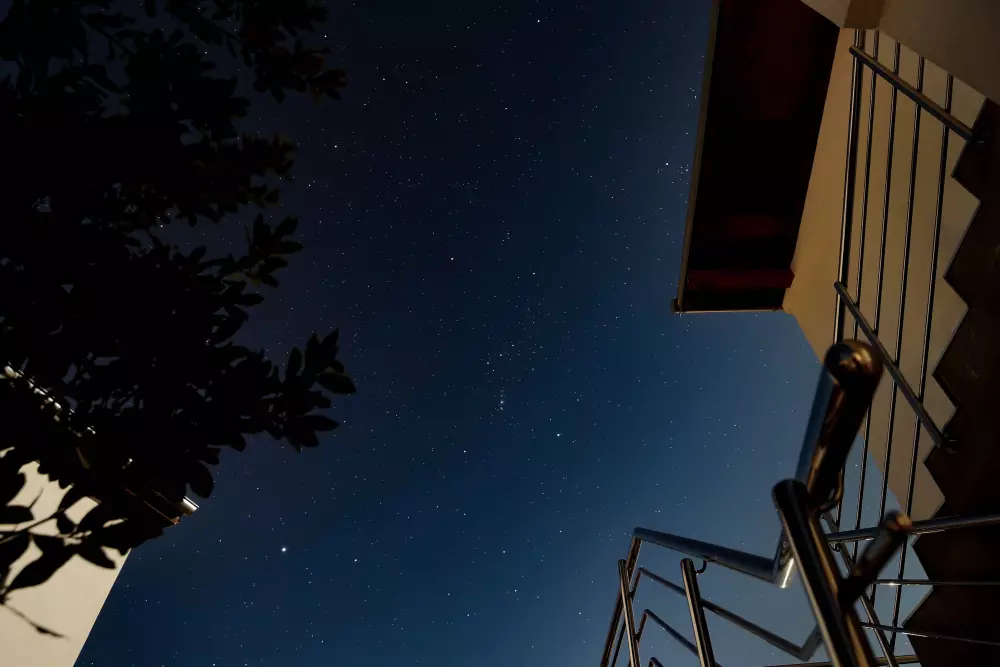
Orion, image: Constellation Guide
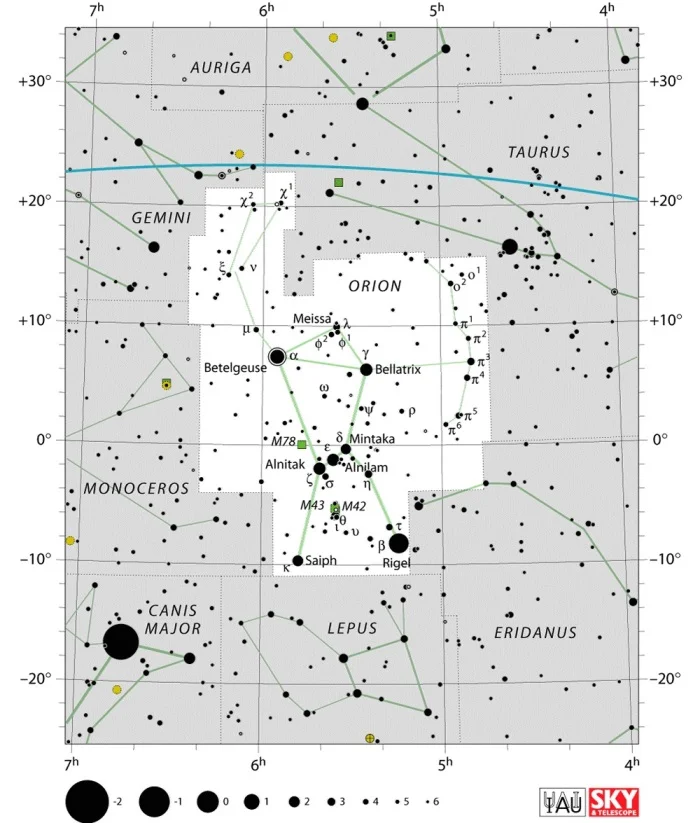
Orion constellation map by IAU and Sky&Telescope magazine (Roger Sinnott & Rick Fienberg) (CC BY 3.0)
Orion mythology
In Greek mythology, the hunter Orion was the most handsome of men. He was the son of the sea god Poseidon and Euryale, the daughter of King Minos of Crete. In Homer’s Odyssey, Orion is described as exceptionally tall and armed with an unbreakable bronze club.
In one myth, Orion fell in love with the Pleiades, the seven sisters, daughters of Atlas and Pleione. He started pursuing them and Zeus scooped them up and placed them in the sky. The Pleiades are represented by the famous star cluster of the same name, located in the constellation Taurus. It is said that Orion can still be seen chasing the sisters across the sky at night.
In a different story, Orion fell in love with Merope, the beautiful daughter of King Oenopion, who did not return his affections. One night, Orion tried to force himself on her. This enraged the king, who put out Orion’s eyes and banished him from his land, the island of Chios.
The god Hephaestus felt sorry for the blind, wandering Orion and offered one of his assistants to guide the hunter and act as his eyes. Orion eventually encountered an oracle that told him if he went east toward the sunrise, his sight would be restored. Orion did so and his eyes were miraculously healed.
The constellation Orion has its origins in Sumerian mythology, specifically in the myth of Gilgamesh. Sumerians associated the constellation with the story of their hero fighting the bull of heaven, represented by Taurus. They called Orion URU AN-NA, meaning “the light of heaven.” Their name for the constellation Taurus was GUD AN-NA, or “the bull of heaven.”
Orion is often shown as facing the charge of a bull, yet there are no myths in Greek mythology telling any such tale. When describing the constellation, the Greek astronomer Ptolemy describes the hero with a club and lion’s pelt, both of which are usually associated with Heracles. However, there is no evidence of a direct relation between the constellation and Heracles in mythology books. Since Heracles, the most famous of Greek heroes, is represented by the much less conspicuous constellation Hercules, and since one of his tasks was to catch the Cretan bull, there are at least hints of a possible connection between the two.
Most myths about Orion’s end involve a scorpion, but the stories differ from one mythographer to another. In one tale, Orion boasted to the goddess Artemis and her mother Leto that he could defeat any beast on earth. The Earth goddess heard him and sent a scorpion, which stung the giant. In another story, he tried to force himself on Artemis and she was the one who sent the scorpion. In yet another account, Orion was stung while trying to save Leto from the scorpion.
All myths of Orion’s passing share the same outcome: Orion and the scorpion were placed on opposite sides of the sky, so that when the constellation Scorpius rises in the sky, Orion sets below the horizon in the west, fleeing from the scorpion.
However, there is also a myth that does not involve a scorpion. In this tale, Artemis the goddess of hunting, fell in love with the hunter. To prevent her from giving up her vows of chastity, her brother Apollo dared her to hit a small target in the distance with her bow and arrow. Not knowing that the target was Orion, who was enjoying a swim, she hit it on the first try. Devastated by his passing, she placed Orion among the stars.
Orion is a well-known constellation in many cultures. In Australia, the stars forming Orion’s Belt and Sword are sometimes called the Pot or the Saucepan. In South Africa, the three stars of Orion’s Belt are known as Drie Konings (the Three Kings) or Drie Susters (the Three Sisters). In Spain and Latin America, the stars are called Las Tres Marías, or the Three Marys.
The Babylonians knew Orion as MULSIPA.ZI.AN.NA or the Heavenly Shepherd (the True Shepherd of Anu) in the Late Bronze Age. They associated the constellation with Anu, the god of the heavenly realms.
The ancient Egyptians associated the Orion constellation the god Sah. Sah was closely associated with Sopdet (Sothis), an Egyptian goddess personified by the star Sirius. Sah and Sopdet are syncretized with Osiris and his wife and sister Isis.
In Egyptian lore, Sah was one of the gods whose form pharaohs take in the afterlife. The disputed Orion correlation theory suggests that the layout of the three largest pyramids of the Giza complex mirrors the alignment of the three stars of Orion’s Belt as they appeared in 10,000 BCE.
Unas, the last pharaoh of the Fifth Dynasty, who reigned in the mid-24th century BCE, was the first Egyptian ruler to have the Pyramid Texts painted and carved on the walls of his pyramid in Saqqara. In these texts, Unas was identified with Osiris and with Ra. In Egyptian lore, Unas travels through the sky to become the star Sabu, or Orion.
The Aztecs called the stars of Orion’s Belt and Sword the Fire Drill. Their rising in the sky signalled the beginning of the New Fire ceremony, a ritual Aztecs performed to postpone the end of the world.
In Hungarian mythology, Orion is identified with Nimrod (Nimród), a famous hunter and father of the twins Hunor and Magor, the ancestors of the Huns and the Magyars (the Hungarians). Orion was also known as the Archer (Íjász) or Reaper (Kaszás), while the Orion’s Belt stars were called Judge’s Stick (Bírópálca).
In Scandinavian tradition, Orion’s Belt is associated with the goddess Freya. It was called Freya’s Distaff or Frigg’s Distaff (Friggerock), after the tool she used for spinning. In Finland, the Belt is called Väinämöinen’s Belt (Väinämöisen vyö) or Väinämöinen’s Scythe (Väinämöisen viikate) and Orion’s Sword is known as Kaleva’s Sword (Kalevanmiekka).
The Chinese knew the constellation as Shen and associated it with a great hunter or warrior. The constellation was named after the three stars of Orion’s Belt. The name Shen (參) means “three.”
Another ancient legend dates back to the second millennium BCE. The Hittites (a Bronze Age people of Anatolia, a region comprising most of the present-day Turkey) associated the constellation with Aqhat, a famous mythical hunter. In local lore, the war goddess Anat fell in love with Aqhat, but after the warrior refused to lend her his bow, she tried to steal it. However, the man she sent to get the bow botched the assignment pretty badly, doing away with Aqhat and dropping the bow into the sea. According to myth, this is why the constellation drops below the horizon for a couple of months in the late spring and early summer.
Constellation figure
Orion is one of the most recognizable constellations in the sky. Its seven brightest stars form a large crooked hourglass figure that dominates the evening sky from November to early March.
Orion is usually depicted with his back turned as he faces the charge of the Bull. Betelgeuse marks his left shoulder, Bellatrix the right, Rigel his right knee and Saiph, the left knee. Alnitak, Alnilam and Mintaka form the Belt of Orion, one of the best-known asterisms in the night sky.
The star systems 42, Theta and Iota Orionis form Orion’s Sword along with the Orion Nebula, which appears as a fuzzy star in the middle of the sword. Meissa marks the Hunter’s head, and Chi1 and Chi2 Orionis appear at the top of his upraised club. The stars Xi and Nu Orionis mark the bend in his arm, and the six stars and star systems that share the Bayer designation Pi Orionis form Orion’s Shield.
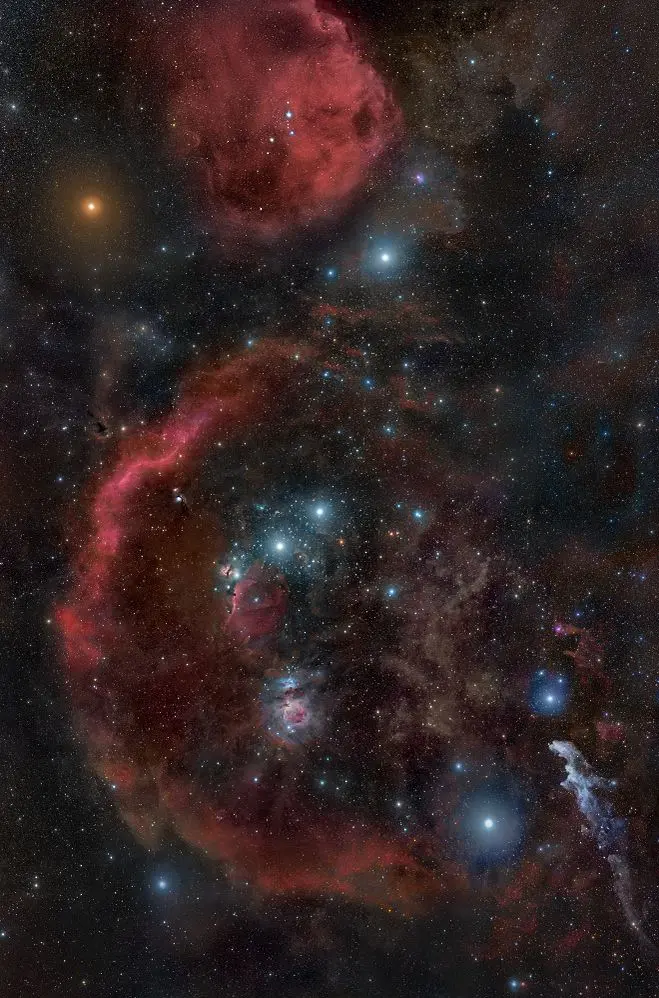
Photo taken by Rogelio Bernal Andreo in October 2010 of the Orion constellation showing the surrounding nebulae of the Orion Molecular Cloud complex. Also captured is the red supergiant Betelgeuse (top left) and the famous Belt of Orion, composed of the OB stars Alnitak, Alnilam and Mintaka. The star Rigel appears to the bottom right. The red crescent shape is Barnard’s Loop. The photograph appeared as the Astronomy Picture of the Day on October 23, 2010. Image credit: Rogelio Bernal Andreo (CC BY-SA 3.0)
Asterisms
The celestial Hunter hosts several familiar constellation-based asterisms: Orion’s Belt, Sword, and Shield, and Venus’ Mirror. These star patterns are quite bright and easy to spot even from light-polluted areas.
The stars of Orion are also part of several larger cross-border asterisms. Betelgeuse is part of the Winter Triangle and the Egyptian X, and Rigel forms the Winter Circle (Winter Hexagon) with five other first magnitude stars. The Winter Circle and the Winter Triangle are prominent in the evening sky throughout the winter months in the northern hemisphere.
Orion’s Belt
Orion’s Belt is one of the best-known asterisms in the night sky. The prominent star pattern is formed by Alnitak, Alnilam, and Mintaka. The three luminous second magnitude stars form a nearly straight line that is visible from both the northern and southern hemispheres for most of the year. The massive blue stars lie approximately 1,200 light-years away.
The asterism has been known since prehistoric times and has many different names across different cultures. Its English names include the Three Kings, Jacob’s Rod, the Three Marys, and the Magi.
Alnitak and Mintaka, the left and right stars of the Belt, are part of multiple star systems, while Alnilam, the middle star, is not known to have any companions. All three stars and some of their close companions are supernova candidates. Alnitak and Alnilam are blue supergiants and Mintaka is a bright giant. Mintaka, the least luminous of the three, shines with 190,000 solar luminosities.
A line extended through the Belt stars leads to Sirius, the brightest star in Earth’s sky. In the opposite direction, it points towards the bright Aldebaran in Taurus.
Orion’s Belt can be used to find several famous deep sky objects that appear in the same region. These include the Flame Nebula (NGC 2024), the Horsehead Nebula (Barnard 33), and the Orion Nebula (Messier 42), the last of which is part of Orion’s Sword.
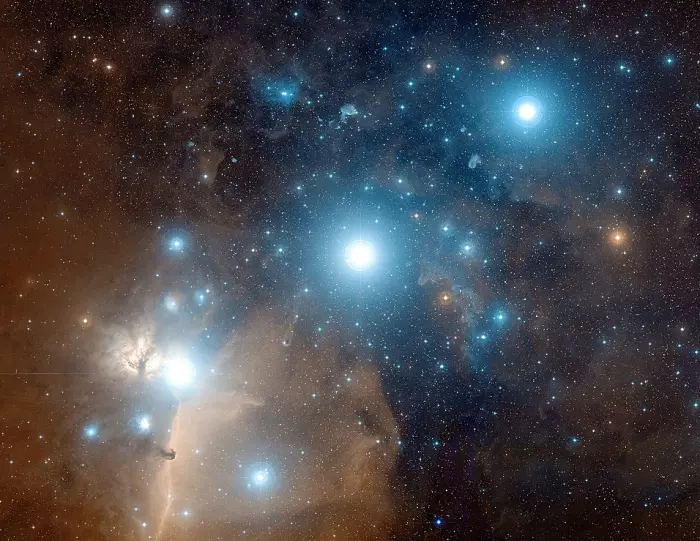
Photo of Orion’s Belt with the stars Alnitak, Alnilam and Mintaka. The color picture was composited from digitized black and white photographic plates recorded through red and blue astronomical filters, with a computer synthesized green channel. The plates were taken using the Samuel Oschin Telescope, a wide-field survey instrument at Palomar Observatory, between 1987 and 1991. Davide De Martin (http://www.skyfactory.org); Credit: Digitized Sky Survey, ESA/ESO/NASA FITS Liberator (PD)
Orion’s Sword
Orion’s Sword is formed by three points of light: the star system 42 Orionis, Theta1 and Theta2 Orionis with the Orion Nebula, and Hatysa (Iota Orionis) with the open cluster NGC 1980. The asterism appears just below Orion’s Belt, in the region between Mintaka and Saiph.
The hot blue star 42 Orionis is one of the stars responsible for making the reflection nebula NGC 1977 (the Running Man Nebula) glow. The Running Man Nebula is part of a larger star forming region Sh2-279.
Theta1 Orionis is the Bayer designation of the Trapezium Cluster, the central young open cluster at the heart of the bright Orion Nebula. On a clear night, the nebula is easily visible as the central point of light in Orion’s Sword. Theta2 Orionis is also a multiple star system. It consists of three stars in a line and appears only a few arcminutes from the Trapezium Cluster.
Hatysa (Iota Orionis), the eighth brightest star in Orion, is the brightest point of light in Orion’s Sword. It is the primary component in a multiple star system located approximately 1,340 light-years away. Shining at magnitude 2.77, the luminous star the brightest member of the open cluster NGC 1980. It has an estimated age of only 4 – 5.5 million years.
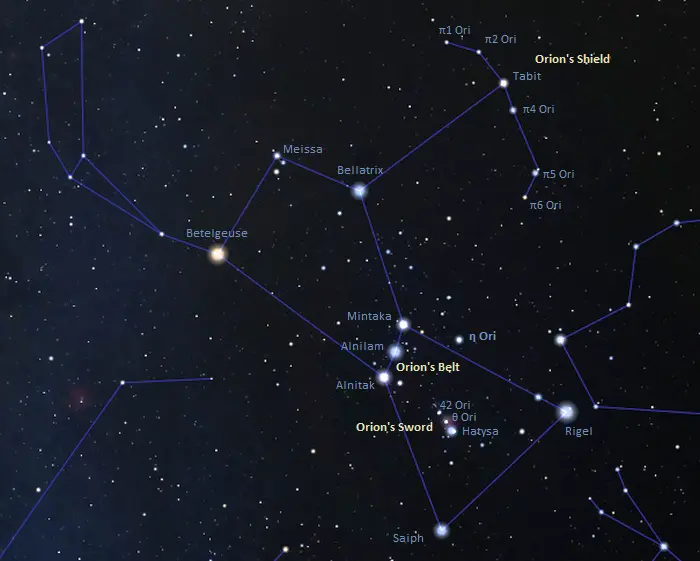
Orion’s Belt, Sword and Shield, image: Stellarium
Orion’s Shield
Orion’s Shield (or Orion’s Bow) is formed by six points of light that share the designation Pi Orionis. The six stars and star systems stretch across an area of almost 9 degrees. Some observers extend the Shield to the north by including Omicron1 or Omicron2 Orionis.
The stars of Orion’s Shield lie at different distances and are not physically related. Pi1 and Pi2 are A-type main sequence stars located 116 and 224 light-years away. Tabit (Pi3 Orionis) is an F-type dwarf only 26.32 light-years away. Pi4 and Pi5 Orionis are hot blue B-type giant stars located 1,050 and 1,300 light-years away, and Pi6 Orionis is an orange giant 950 light-years away.
Pi1 Orionis, the northernmost star in the Shield, lies near the midpoint of the imaginary line connecting Bellatrix in Orion and Aldebaran in Taurus.
Venus’ Mirror
Venus’ Mirror is a four-sided asterism formed by the stars of Orion’s Belt and Orion’s Sword with Eta Orionis, the brightest star in the region between Mintaka and Rigel. The asterism is also known as the Saucepan.
NGC 1807
NGC 1807 is an asterism located on the border between Orion and Taurus. It has an apparent magnitude of 7.0 and an apparent size of 5.4 arcminutes. It appears near the open cluster NGC 1817.
NGC 1807 was discovered by the English astronomer John Herschel on January 25, 1832. Both Herschel and Danish astronomer John Louis Emil Dreyer, who compiled the New General Catalogue, believed that the object was a star cluster. Dreyer described it as a “cluster, pretty rich, large and small stars.”
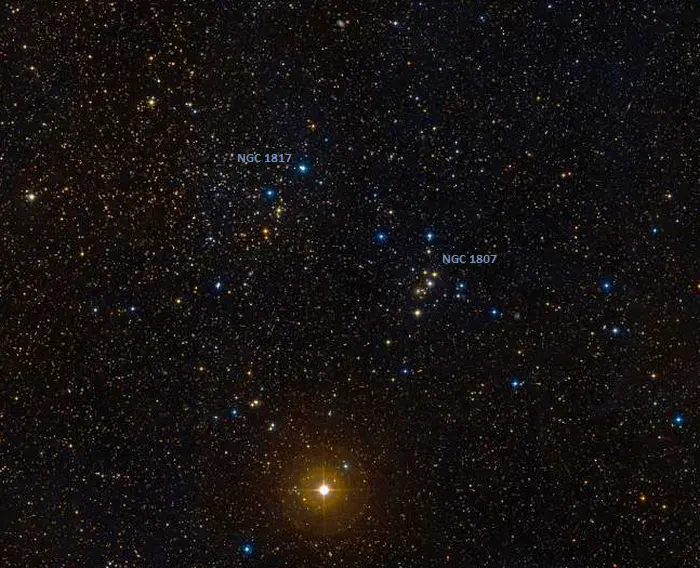
NGC 1807 and NGC 1817, image credit: ESO/Digitized Sky Survey 2 (CC BY 4.0)
Winter Circle (Winter Hexagon)
The Winter Circle is the brightest asterism in the northern winter sky. It is formed by six first magnitude stars: Rigel in Orion, Sirius in Canis Major, Procyon in Canis Minor, Pollux in Gemini, Capella in Auriga, and Aldebaran in Taurus. The asterism dominates the evening sky during the northern hemisphere winter.
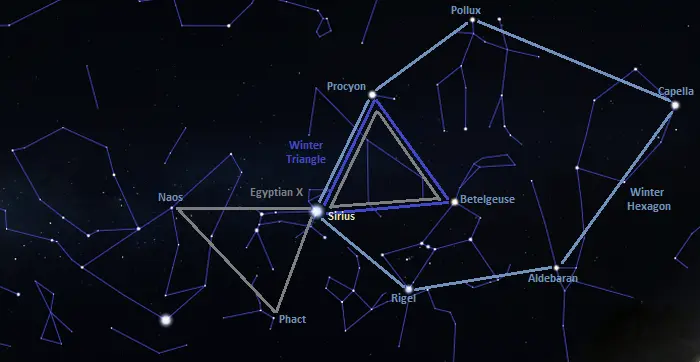
The Winter Triangle, Winter Hexagon and Egyptian Cross, image: Stellarium
Heavenly G
The Heavenly G is slightly different version of the Winter Hexagon. It turns the circle into a “G” by including Bellatrix and sometimes Betelgeuse at Orion’s shoulders.
Winter Triangle
The Winter Triangle is formed by Betelgeuse in Orion with Sirius in Canis Major and Procyon in Canis Minor. It is also known as the Great Southern Triangle. It appears within the Winter Circle. Betelgeuse appears near the centre of the larger asterism.
The stars of the Winter Triangle can be used to find the Rosette Nebula, the Cone Nebula, Hubble’s Variable Nebula, and the bright open star cluster Messier 50 in the faint constellation of Monoceros. Most of the Unicorn constellation appears within the Winter Triangle.
Egyptian X
The Egyptian X (or Egyptian Cross) is formed by the stars of the Winter Triangle – Sirius, Procyon and Betelgeuse – with Naos in the constellation Puppis and Phact in Columba. Naos and Phact form a triangle with Sirius, and the two triangles meet at Sirius.
The asterism is not easily seen from most of Europe because Naos and Phact do not rise very high above the horizon – if at all – for observers in the mid-northern latitudes.
Major stars in Orion
Orion is one of the brightest constellations in the sky. Its brightest stars – the supergiants Rigel and Betelgeuse – are on average the seventh and 10th brightest stars in the sky.
In addition to these two first-magnitude stars, the constellation contains five second magnitude stars – Bellatrix, Alnilam, Alnitak, Saiph, and Mintaka – which complete the constellation figure of the celestial Hunter.
Most Orion’s bright stars are members of the Orion OB1 association. These stars lie approximately 1,040 to 1,630 light-years away and have an estimated age of around 10 million years. Many of them have masses more than 8 times that of the Sun and will end their lives as luminous supernovae.
Most of Orion’s bright stars form binary and multiple star systems as they have not yet had the time to move away from their birthplace and siblings. These stars formed in the Orion Molecular Cloud Complex (OMCC), a giant stellar nursery that contains many bright nebulae associated with young star clusters, including the Orion Nebula (M42), the Flame Nebula (NGC 2024), and the Lambda Orionis Cluster (Collinder 69).
Rigel – β Orionis (Beta Orionis, 19 Orionis)
Rigel (β Ori) is the brightest star in Orion. It has a mean apparent magnitude of 0.13 and lies approximately 848 light-years away. Even though it does not have the Bayer designation Alpha, it is almost always brighter than Betelgeuse (Alpha Orionis).
Rigel is a hot blue supergiant of the spectral type B8 Ia. It has a mass 21 times that of the Sun and a radius 74.1 times the Sun’s. With an effective temperature of 12,100 K, it shines with 120,000 solar luminosities. The supergiant star spins at around 25 km/s. It has an estimated age of only 8 million years.
Rigel is believed to be an outlying member of the Orion OB1 association, a group of young, luminous O- and B-type stars formed in the Orion Molecular Cloud Complex. It is a member of the loosely defined Taurus-Orion R1 association.
Like many of its bright Orion neighbours, the blue supergiant will go out as a type II supernova when it comes to the end of its life cycle in a few million years.
Rigel is part of a multiple star system that includes at least three other stars. Rigel B is a spectroscopic binary system with an apparent magnitude of 6.7. Both components, Rigel Ba and Rigel Bb, are hot blue B-type main sequence stars. Rigel C is also a B-type main star. The Rigel BC system is separated by 9.5 arcseconds from Rigel. Rigel and Rigel BC have an orbital period of around 24,000 years.
All three fainter companions are more massive than the Sun. They have masses of 3,84, 2.94, and 3.84 times that of the Sun, respectively.
Rigel B and Rigel C complete an orbit around a common centre of mass every 63 years, and Rigel Ba and Bb take only 9.860 days to complete an orbit.
Rigel was discovered to be a double star by the German-born British astronomer William Herschel in October 1781. The visual companion was resolved into two components by the American astronomer Sherburne Wesley Burnham in 1878. Rigel B was resolved into two stars using speckle interferometry in 2009.
Rigel is losing mass at a rate of 10 million times that of the Sun and is surrounded by a shell of expelled gas. The supergiant is believed to have started its main sequence life with a mass of about 24 solar masses. It has already lost about 3 solar masses of material through a strong stellar wind.
The name Rigel comes from the Arabic phrase Riǧl Ǧawza al-Yusra (rijl al-jauza al-yusra), meaning “the left foot of the central one.” The name refers to the supergiant’s position in the constellation, marking Orion’s foot. Another Arabic name for the star is iǧl al-ǧabbār, or “the foot of the great one.” The star’s other two variant names, Algebar and Elgebar, are derived from this phrase.
Rigel is associated with the faint reflection nebula IC 2118, also known as the Witch Head Nebula. The nebula appears about 2.5 degrees northwest of Rigel, in the constellation Eridanus. It is illuminated by the supergiant’s light.
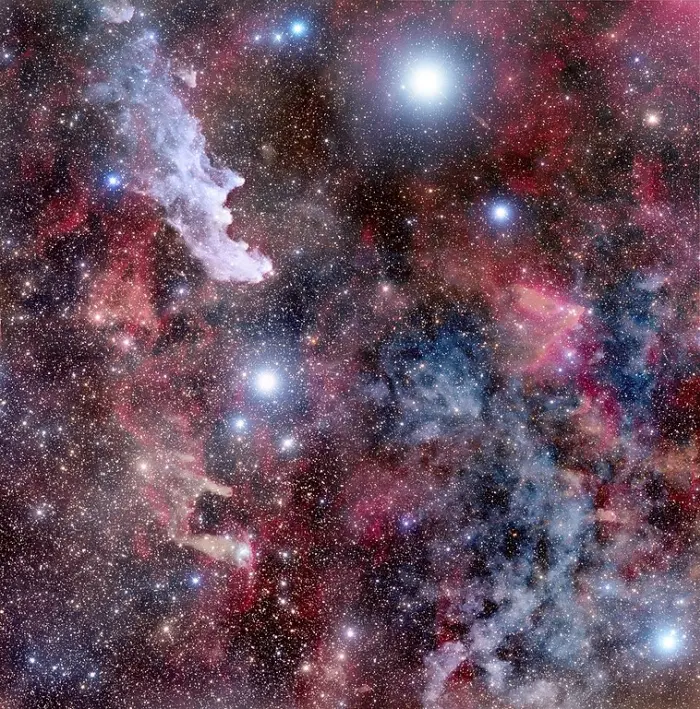
Rigel and the Witch Head Nebula (IC 2118), image credit: Adam Block (CC BY-SA 4.0)
Betelgeuse – α Orionis (Alpha Orionis, 58 Orionis)
Betelgeuse (α Ori) is a red supergiant located approximately 548 light-years away. It is the second brightest star in Orion and the 10th brightest star in the sky. It has an apparent magnitude of 0.50.
Betelgeuse has the spectral class M1–M2 Ia–ab, indicating an intermediate luminosity supergiant. It is a semiregular variable star whose brightness has been observed to vary from magnitude 0.0 to 1.6. At its brightest, the supergiant star is brighter than Vega in the constellation Lyra and rivals Arcturus in Boötes. At its faintest, it drops to second magnitude and is about as bright as Castor in Gemini and Shaula in Scorpius.
Betelgeuse is an evolved, massive star that will likely meet its end as a supernova within about 100,000 years. It has a mass of 14 – 19 solar masses. The star’s radius is uncertain and difficult to measure, but estimates are generally in the range between 640 and 764 solar radii.
With a surface temperature of 3,600 – 3,800 K, Betelgeuse is about 65,000 times more luminous than the Sun. It spins at 5.47 km/s, taking around 36 years to complete a rotation. It has an estimated age of 8 – 14 million years.
Betelgeuse is one of the largest stars visible to the unaided eye. The star’s radius is difficult to measure accurately because the star appears to change shape from time to time and, as a result of a huge mass loss, it has a large envelope surrounding it. Like all pulsating stars, the supergiant changes in size, temperature and brightness.
The variability of Betelgeuse was known since at least 1836, when the English astronomer Sir John Herschel described it in his Outlines in Astronomy. Herschel noted that Betelgeuse outshone Rigel in October 1837 and November 1839.
Even though it is a very young star, Betelgeuse has evolved very rapidly due to its enormous mass. When it goes out as a supernova, the event will be visible in daylight for 2 – 3 months. The supernova will not be quite as bright as the full Moon, but it will have a significant fraction of its brightness.
The origin of the name Betelgeuse is not entirely certain. The last part, -elgeuse, is derived from the Arabic name for the constellation, al-Jauzā’, which was a feminine name from old Arabian legends and can be roughly translated as “the middle one.”
The most widely accepted explanation is that the name is a corruption of the Arabic phrase Yad al-Jauzā’ , the Hand of al-Jauzā’ (the hand of Orion), which became Betelegeuse through a mistransliteration into medieval Latin, with the first Arabic letter standing for y being mistaken for the one for b. This led to the name Bait al-Jauzā’ or “the house of Orion” during the Renaissance period and to the star’s modern name, Betelgeuse.
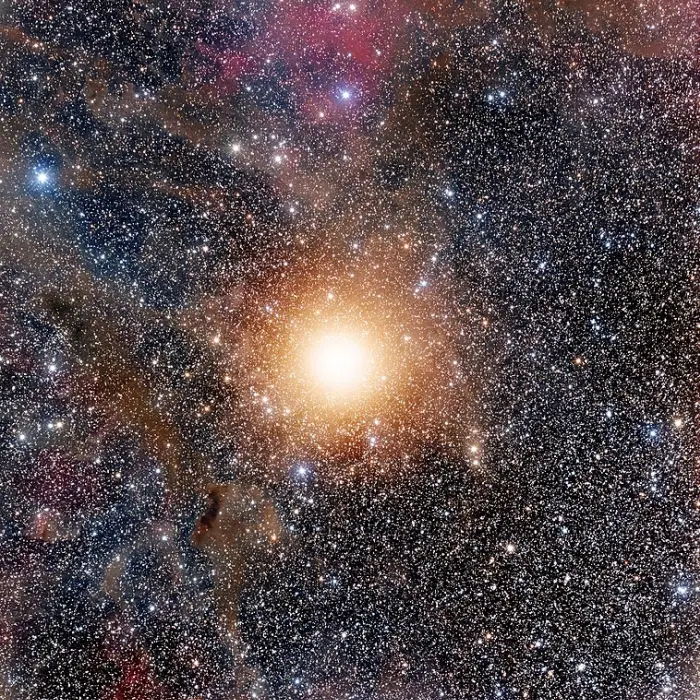
Betelgeuse is usually the tenth-brightest star in the night sky and, after Rigel, the second-brightest in the constellation of Orion. It is a distinctly reddish semiregular variable star whose apparent magnitude, varying between +0.0 and +1.6, has the widest range displayed by any first-magnitude star. Image credit: Adam Block/Steward Observatory/University of Arizona (CC BY-SA 3.0)
Bellatrix – γ Orionis (Gamma Orionis, 24 Orionis)
Bellatrix (γ Ori) is the nearest of the bright Orion stars to the Sun. It shines at magnitude 1.64 from a distance of 250 light-years. It marks Orion’s right shoulder.
Bellatrix is the third brightest star in Orion and the 26th brightest star in the sky. It is only slightly dimmer than Castor in Gemini, Shaula in Scorpius, and Gacrux in Crux. The young blue star has an estimated age of 25.2 million years.
Gamma Orionis has the spectral type B2 V, indicating a hot blue main sequence star. The star has 7.7 times the Sun’s mass and a radius of 5.75 solar radii. With a surface temperature of 21,800 K, it is 9,211 times more luminous than the Sun. It spins at 52 km/s.
With a mass of 7.7 solar masses, Bellatrix may or may not end its life as a supernova. If it does not go out as a supernova, it will end its life as a massive white dwarf.
Bellatrix is a suspected variable star. Its brightness varies between magnitudes 1.59 and 1.64. It may be a spectroscopic binary star, but it is not known to have any companions that can be visually resolved.
The name Bellatrix comes from the Latin bellātrix, meaning “female warrior.” Gamma Orionis was sometimes also called the Amazon Star.
Alnilam – ε Orionis (Epsilon Orionis, 46 Orionis)
Alnilam (ε Ori), the middle star of Orion’s Belt, is a massive blue supergiant star located approximately 1,180 light-years away. With a mean apparent magnitude of 1.69, it is the fourth brightest star in Orion and, on average, the 29th brightest star in the sky.
Alnilam has the stellar classification B0 Ia, indicating a luminous, hot blue supergiant. With a mass of 40 solar masses, the star is destined to go out as a supernova and leave behind a black hole within the next few million years. It has an estimated age of only 4.47 million years. Before it reaches the end of its life cycle, it may evolve into a Wolf-Rayet star.
Alnilam has a radius 30.62 times that of the Sun and shines with 419,600 solar luminosities. It is one of the most luminous stars visible to the unaided eye. It has an effective temperature of 26,540 K and an absolute magnitude of -6.89.
Alnilam is surrounded by the reflection nebula NGC 1990, a molecular cloud illuminated by the light emitted by the star. The wind blowing from the star’s surface has the speed of 2,000 kilometres per second, causing the supergiant to lose mass 20 million times faster than the Sun.
The disputed nebula NGC 1990 was reported by William Herschel in 1786, but its existence has not been confirmed by modern instruments, so its exact location and size remain undefined.
The name Alnilam comes from the Arabic word an-niżām, meaning “the string (of pearls).” The name was historically also spelled Alnihan and Alnitam.
Alnitak – ζ Orionis (Zeta Orionis, 50 Orionis)
Alnitak (ζ Ori) is a blue supergiant of the spectral type O9.5 Iab, located approximately 1,260 light-years away. It forms a triple star system with a hot blue subgiant of the spectral type B1IV and a giant with the stellar classification B0III. With a combined apparent magnitude of 1.77, it is the fifth brightest point of light in Orion. Alnitak is the easternmost star of Orion’s Belt.
The individual components of the Zeta Orionis system shine at magnitudes 2.08, 4.28, and 4.01. They are members of the Orion OB1b subgroup of the Orion OB1 association. The primary component, Zeta Orionis Aa (Alnitak) is the brightest O-type star in the sky.
Alnitak was discovered to be a double star by German amateur astronomer George K. Kunowsky in 1819. The brighter visual component was found to be a close binary system in 1998.
Zeta Orionis Aa and Ab take 2,687.3 days to complete an orbit around a common centre of mass. Zeta Orionis B (Alnitak B) orbits the pair with a period of 1,508.6 years.
The primary star has a mass of 33 solar masses and a radius 20 times that of the Sun. With a surface temperature of 29,500 K, it shines with 250,000 solar luminosities. It has an estimated age of only 6.4 million years. It spins at about 110 km/s, taking 6.67 days to complete a rotation.
The closer companion, Alnitak Ab, has 14 times the Sun’s mass and a radius of 7.3 solar radii. It is 32,000 times more luminous than the Sun and has a surface temperature of 29,000 K. It is slightly older than Alnitak, with an estimated age of 7.2 million years. The components Zeta Ori Aa and Ab are both supernova candidates.
The name Alnitak is derived from the Arabic word an-nitaq, meaning “the girdle.”
Alnitak lies in the same area as the emission nebula IC 434, the Flame Nebula (NGC 2024), and the Horsehead Nebula (Barnard 33).
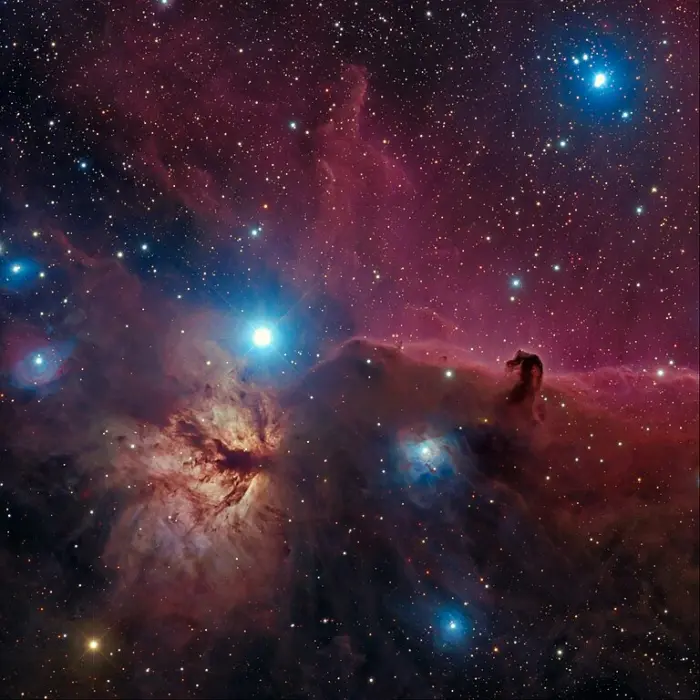
Alnitak, the Flame Nebula and the Horsehead Nebula, image credit: ESO/DSS2, WISE, Giuseppe Donatiello (CC0 1.0)
Saiph – κ Orionis (Kappa Orionis, 53 Orionis)
Saiph (κ Ori) is a bright supergiant of the spectral type B0.5 Ia, located around 650 light-years away. It is the south-eastern star of Orion’s central quadrangle. With an apparent magnitude of 2.09, it is the sixth brightest star in the constellation. In the constellation figure of Orion, Saiph marks the Hunter’s left foot or knee.
Estimates of the star’s mass are in the range between 15.5 and 21.1 solar masses, sealing the supergiant’s fate as a spectacular supernova in the not-too-distant astronomical future.
Saiph has expanded to a size of 13 – 14 solar radii as it evolved away from the main sequence. With a surface temperature of around 25,700 K, it is 60,300 times more luminous than the Sun. It spins with a projected velocity of 83 km/s. The star has an estimated age of 11.1 or 5.6 million years.
The name Saiph is derived from the Arabic phrase saif al jabbar, meaning “the sword of the giant.” The supergiant was historically also known as Rekbah al Jauza al Yemeniat, meaning “the right knee of the giant.”
Mintaka – δ Orionis (Delta Orionis, 34 Orionis)
Mintaka (δ Ori), the westernmost of the three stars of the Belt of Orion, is a hot blue bright giant star with the stellar classification O9.5II. It shines at magnitude 2.23 from a distance of 1,200 light-years and is the seventh brightest star in Orion. To observers in the northern hemisphere, Mintaka is the rightmost star of Orion’s Belt.
At declination -00° 17’, Mintaka is the closest bright star to the celestial equator. It rises and sets almost exactly east and west.
Mintaka is part of a multiple star system. The primary component, Delta Orionis Aa1, has a mass 17.8 times that of the Sun and a radius of 13.1 solar radii. It is 190,000 times more luminous than the Sun, with a surface temperature of 31,400 K. The star is a fast rotator, with a projected rotational velocity of around 114 km/s.
Mintaka forms a triple star with two fainter companions, designated Delta Orionis Aa2 and Delta Orionis Ab. Both are hot blue stars, with the spectral types B1V and B0IV. Delta Orionis Aa1 and Aa2 take 5.732436 days to complete an orbit around a common centre of mass, and the component Delta Orionis Ab orbits the pair with a period of 53,839 days.
Delta Orionis A is classified as an eclipsing binary system. The system’s brightness varies because the components Delta Orionis Aa1 and Aa2 periodically eclipse each other during their orbit.
The closer of the two, Delta Orionis Aa2, is a main sequence star with a mass of 8.518 solar masses and a radius of 4.168 solar radii. With an effective temperature of 25,442 K, it shines with 16,000 solar luminosities. It spins at 89 km/s.
The component Delta Orionis Ab is a blue subgiant with 8.787 times the Sun’s mass and a radius 12.045 times the Sun’s. It has 63,000 times the Sun’s luminosity and an effective temperature of 30,250 K. It spins at 216 km/s.
Delta Orionis B, a more distant companion, is a much cooler star, with a surface temperature of 5,324 K. It has a radius only 77% that of the Sun and shines with 43.1% of the Sun’s luminosity.
The system has another member, the chemically peculiar B-type star HD 36485. It is another massive star, with an estimated mass between 6 and 11 times that of the Sun. The star has 5.7 times the Sun’s radius and shines with 3,300 solar luminosities. It has an effective temperature of 18,400 K.
The name Mintaka is derived from the Arabic word manţaqah (or manṭaqa), meaning “belt.”
Hatysa – ι Orionis (Iota Orionis)
Hatysa (ι Ori) is the primary component in a multiple star system located approximately 1,340 light-years away in Orion. It is the brightest star in Orion’s Sword and marks the sword’s tip.
The star has the proper name Hatysa, of uncertain origin. It was traditionally known as Na’ir al Saif, meaning “the bright one of the sword” in Arabic.
With an apparent magnitude of 2.77, Iota Orionis is the eighth brightest star in Orion. The young star system is a member of the open cluster NGC 1980.
The three visible components of the Iota Orionis system are designated Iota Orionis A, B, and C. The component A is itself a spectroscopic binary star. The primary component, Iota Orionis Aa1, is formally known as Hatysa. The two close companions are designated Iota Orionis Aa2 and Ab.
Hatysa has 23.1 times the Sun’s mass and a radius 8.3 times that of the Sun. It is 68,000 times more luminous than the Sun, with an effective temperature of 32,500 K. It spins at 122 km/s.
Even though it is a young star, with an estimated age of 4 – 5.5 million years, Hatysa has already evolved away from the main sequence and expanded into a giant. It has the spectral type O9 III. Like many of its bright Orion neighbours, it will go out as a supernova when it reaches the end of its life cycle.
The two close companions are hot blue stars of spectral types B0.8 III/IV and B2:IV. The spectroscopic companion, Iota Ori Aa2, is also a supernova candidate. It has a mass od 13.1 solar masses and a radius 5.4 times that of the Sun. It appears older than Hatysa, with an estimated age of 9.4 million years.
The component Iota Orionis B appears at a separation of 11 arcseconds from the primary, corresponding to a physical distance of around 5,000 astronomical units (AU). It is a pre-main sequence star with the spectrum of a B8 giant. It is classified as an Orion variable.
Iota Orionis C is separated by 49 arcseconds from the primary component. It has the stellar classification A0.
Tabit – π3 Orionis (Pi3 Orionis)
Tabit (π3 Ori) is a main sequence star of the spectral type F6 V, located 26.32 light-years away. With an apparent magnitude of 3.65, it is the ninth brightest star in Orion.
Tabit is the brightest of the six stars that form Orion’s Shield (or Bow). It shares the designation Pi Orionis with five other stars and star systems that form the giant’s shield, but it lies much closer and is not physically related to them.
Tabit is younger, hotter and more massive than the Sun. It has a mass of 1.288 solar masses and a radius 1.317 times that of the Sun. With an effective temperature of 6,518 K, it shines with 2.816 solar luminosities. The star has an estimated age of 1.04 billion years. It spins at 17 km/s.
Pi3 Orionis has been used as a spectral standard for its class since 1943. Its spectrum serves as one of the stable anchor points in the Morgan-Keenan system and is used to classify other stars.
The name Tabit comes from the Arabic Al-Tabit (al-thābit), meaning “the endurer” or “the fixed/constant one.”
The other stars that share the Bayer designation Pi Orionis lie at much greater distances.
Pi1 Orionis (π1 Ori) is a main sequence star of the spectral type A3 Va, located around 116 light-years away. It has an apparent magnitude of 4.74. It has a mass of 1.97 solar masses and a radius of 1.67 solar radii. It spins at 120 km/s and has an estimated age of 100 million years. The star has a debris disk orbiting at a distance of about 50 AU.
Pi2 Orionis (π2 Ori) has the stellar classification A1 Vn, indicating a white main sequence star. It shines at magnitude 4.35 from a distance of around 224 light-years. It has a radius 2.7 times that of the Sun and shines with 70 solar luminosities. The star is a very fast spinner, with a projected rotational velocity of 261.4 km/s. As a result, it has a flattened shape with an equatorial bulge.
Pi4 Orionis (π4 Ori) a hot blue giant star of the spectral type B2 III. It has an apparent magnitude of 3.685 and lies approximately 1,050 light-years away. It appears as a single star to the unaided eye, but is really a spectroscopic binary system with an orbital period of only 9.5 days.
The primary component, Pi4 Orionis A, is a supernova candidate. It has a mass of 10.95 solar masses and 9.1 times the Sun’s radius. With an effective temperature of 21,874 K, it is 19,726 times more luminous than the Sun. The star has an estimated age of around 15.4 million years.
Pi5 Orionis (π5 Ori) is another blue giant in Orion’s Shield. It has the spectral type B2 III and shines at magnitude 3.69 from a distance of 1,300 light-years. It is a spectroscopic binary star whose components take only 3.7005 days to complete an orbit.
The system is classified as an ellipsoidal variable and the primary component is believed to be a slowly pulsating B-type star. Rotating ellipsoidal variables are close binary stars whose shapes are distorted by mutual gravitation. The two components of Pi5 Ori are separated by 25.9 astronomical units (Earth – Sun distances). As they orbit and their orientation with respect to our line of sight changes, the system’s brightness varies by 0.05 magnitudes.
Both components of Pi5 Orionis are much more massive and luminous than the Sun. They have masses of 12 and 5 solar masses and shine with 11,262 and 525 – 741 solar luminosities, respectively.
Pi6 Orionis (π6 Ori) is an orange giant with the stellar classification K0/1 III, located 950 light years away. It has an apparent magnitude of 4.469. It has a mass 4.15 times that of the Sun and a radius of 87.73 solar radii. With a surface temperature of 4,217 K, it shines with 2,185.6 solar luminosities. The star has an estimated age of 230 million years.
η Orionis (Eta Orionis)
Eta Orionis (η Ori) is a multiple star system located approximately 1,000 light-years away. It has a combined apparent magnitude of 3.42. It is the brightest point of light in the region between Mintaka and Rigel.
Eta Orionis is a member of the Orion OB1a association. The star was traditionally known as Algjebbah, Ensis (“sword” in Latin) and Saiph. It does not have a proper name approved by the International Astronomical Union. The name Saiph formally applies to Kappa Orionis.
The primary component, Eta Orionis A, is a spectroscopic triple star. The components Eta Orionis Aa and Ab form a close binary system with an orbital period of under eight days. They are separated by about one tenth of an astronomical unit (Earth – Sun distance). The component Eta Orionis Ac appears at a separation of only 0.04 arcseconds and takes 9.4 years to complete an orbit around the Aa/Ab pair.
The components Eta Orionis Aa and Ab form an eclipsing binary system classified as an Algol variable. The system’s brightness drops from magnitude 3.31 to magnitude 3.6 every four days when the two components pass in front of each other.
The components Aa and Ab are both supernova candidates, with masses of 11 and 10.6 times that of the Sun. Both stars have surface temperatures of 26,600 K. Eta Orionis Aa has a radius of 6.3 solar radii and Eta Orionis Ab, 5.2 solar radii. Eta Orionis Ab and Eta Orionis B are slightly less massive. They have masses of 6.78 and 8.7 solar masses respectively.
Meissa – λ Orionis (Lambda Orionis)
Meissa (λ Ori) is a hot blue giant located approximately 1,300 light-years away. Located north-west of Betelgeuse, the luminous star marks Orion’s head. It is part of a multiple star system. It shines at magnitude 3.7.
The two brightest components, Lambda Orionis A and B, are separated by about 4.41 arcseconds.
The primary component, formally known as Meissa, is a luminous giant star of the spectral type O8 III((f)). With 34 times the Sun’s mass, it is a supernova candidate. It has a radius 13.4 times that of the Sun. With a surface temperature of 35,000 K, it is around 200,000 times more luminous than the Sun. The star has an estimated age of only 4.2 million years.
Lambda Orionis B, the second brightest component in the Lambda Orionis system, has an apparent magnitude of 5.6. It has the stellar classification B0 V, indicating a hot blue main sequence star. Like Meissa, it is a supernova candidate. It has a mass of 10.3 solar masses and a radius 4.2 times that of the Sun. With an effective temperature of 25,400 K, it is 6,300 times more luminous than the Sun. The star is slightly younger than the primary component, with an estimated age of only 1.8 million years.
The system has another component, Lambda Orionis C, a main sequence star of the spectral type F8 V. Meissa C may have a low-mass companion believed to be a brown dwarf.
The name Meissa comes from the Arabic Al-Maisan, meaning “the shining one.” It originally applied to Alhena (Gamma Geminorum) in the constellation Gemini, but was applied to Lambda Orionis by mistake and it stuck.
Lambda Orionis originally had the Arabic name Al Hakah, derived from Al Haḳʽah, meaning “a white spot.” Al Hakah was the name of an Arabic lunar mansion that included Lambda and Phi Orionis.
Lambda Orionis is the brightest member of the young open cluster Collinder 69. Also known as the Lambda Orionis Cluster, the cluster has an estimated age of 5 million years. With an apparent magnitude of 2.8, it is visible to the unaided eye.
The cluster is surrounded by a molecular cloud and H II region known as the Lambda Orionis Ring. Catalogued as Sharpless 264 and popularly known as the Angelfish Nebula, the star forming region is best seen in long-exposure photographs.
τ Orionis (Tau Orionis)
Tau Orionis (τ Ori) is a hot blue giant star of the spectral type B5 III. It lies 490 light-years away and has an apparent magnitude of 3.58. It appears roughly one sixth of the way from Rigel to Mintaka.
The star has a mass 6.2 times that of the Sun and a radius of 5.4 solar radii. With an effective temperature of 10,829 K, it is 933 times more luminous than the Sun. It has an estimated age of 63.1 million years.
σ Orionis (Sigma Orionis)
Sigma Orionis (σ Ori) is a multiple star system located approximately 1,263 light-years away. The star system is composed of bright members of an open cluster. It lies southwest of Alnitak, in the eastern part of the Orion’s Belt region. The system has a combined apparent magnitude of 3.80. It is a member of the Orion OB1b stellar association.
The individual components have apparent magnitudes of 4.07 (Sigma Orionis A), 5.27 (Sigma Orionis B), 8.79 (Sigma Orionis C), 6.62 (Sigma Orionis D), and 6.61 – 6.77 (Sigma Orionis E).
Sigma Orionis A is itself a close triple system, consisting of a spectroscopic binary pair and a companion at a wide separation. The inner pair was resolved using interferometry in 2013. The two stars have an orbital period of 143.2002 days and are separated by only 0.0042860 arcseconds. The primary component has the spectral type O9.5 V.
The five brightest components of the Sigma Orionis cluster are much more massive than the Sun. Sigma Orionis Aa has 18 times the Sun’s mass and a radius of 5.6 solar radii. It is 41,700 times more luminous than the Sun. It has an estimated age of only 0.3 million years.
Sigma Orionis Ab has a mass of 13 solar masses and a radius 4.8 times that of the Sun. It is believed to be 0.9 million years old. It shines with 18,600 solar luminosities and has an effective temperature of 31,000 K.
Sigma Orionis B has the stellar classification B0.5 V, indicating a hot blue main sequence star. It has 14 times the Sun’s mass and a radius of 5 solar radii. The star is a very fast spinner, with a projected rotational velocity of 250 km/s. It has an estimated age of 1.9 million years.
Sigma Orionis C is the coolest and faintest of the five bright components. It is a white main sequence star of the spectral type A2 V. With 2.7 times the mass of the Sun, it is also the least massive of the five.
Sigma Orionis D and Sigma Orionis E are both hot blue main sequence stars of the spectral type B2 V. They have masses of 6.8 and 8.30 solar masses and surface temperatures of 21,500 and 22,500 K. Both stars are fast spinners, with rotational velocities of 180 and 140 km/s.
Sigma Orionis E is classified as an SX Arietis variable. These are B-type variable stars with strong magnetic fields and strong spectral lines of He I and Si III. Their brightness typically varies by around 0.1 magnitudes with periods of around a day.
The Sigma Orionis cluster contains a several dozen other members of spectral types A and B, as well as several hundred low-mass stars and brown dwarfs.
φ1 Orionis (Phi1 Orionis)
Phi1 Orionis (φ1 Ori) is a double star located 1,090 light-years away. It appears less than a degree south of Meissa, the star that marks Orion’s head, and is a member of the Lambda Orionis Cluster. The binary star system has an apparent magnitude of 4.42.
Phi1 Orionis is a single-lined spectroscopic binary star, which means that the spectrum of only one component is visible. The presence of the companion can be inferred by spectral lines periodically shifting towards the blue and then towards the red, indicating orbital motion.
The two components have an orbital period of 3,068 days. They have an estimated age of 7 million years.
The primary star is a hot blue giant of the spectral type B0 III. With a mass of 15.5 solar masses, it is a supernova candidate. The star has a radius of 6.3 solar radii and shines with 28,840 solar luminosities. It has a surface temperature of around 30,000 K.
Phi1 Orionis shares the Bayer designation Phi Orionis with the brighter Phi2 Orionis, but the stars are not physically related. Phi1 lies at a much greater distance.
φ2 Orionis (Phi2 Orionis)
Phi2 Orionis (φ2 Ori) is a yellow giant or subgiant of the spectral type G8 III-IV, located around 113.8 light-years away. It has an apparent magnitude of 4.081. Like Phi2 Ori, it appears near Meissa.
The evolved star has a mass of 1.07 solar masses and has expanded to a size of 8.22 solar radii as it started to evolve away from the main sequence. With an effective temperature of 4,703 K, it is 29.8 times more luminous than the Sun.
The star is older than the Sun. It has an estimated age of 6.91 billion years.
χ1 Orionis (Chi1 Orionis)
Chi1 Orionis (χ1 Ori) is a Sun-like yellow main sequence star located 28.4 light-years away in Orion. It appears at the top of Orion’s upraised club.
The star is classified as an RS Canum Venaticorum variable. Its brightness varies between magnitudes 4.38 and 4.41 with a period of 5.5 days. RS CVn stars are close binary systems with active chromospheres that produce large stellar spots, which cause the variations in brightness.
The primary component has a mass of 1.01 solar masses and a radius of 0.983 solar radii. With a surface temperature of 5,883 K, it shines with 1.042 solar luminosities. With a rotational velocity of 8.7 km/s, the star takes 5.2 days to complete a rotation. It has an estimated age of 300 – 400 million years.
The fainter companion is a red dwarf with a mass of only 0.15 solar masses and an estimated age of 70 – 130 million years. The companion is believed to be a pre-main sequence star.
The two components orbit each other with a period of 14.1 years at an average distance of 6.1 astronomical units.
χ2 Orionis (Chi2 Orionis)
Chi2 Orionis is a hot blue supergiant of the spectral type B2Ia. It shines at magnitude 4.63 from a distance of 4,300 light-years. It is located near the border with the constellation Gemini.
With a mass 42.3 times that of the Sun, the star is a supernova candidate. Even though it is only 5 million years old, it is already approaching the end of its life cycle due to its high mass. It is 446,000 times more luminous than the Sun, with an effective temperature of 19,000 K.
Chi2 Orionis is classified as an Alpha Cygni variable. Named after the prototype Deneb (Alpha Cygni), the brightest star in Cygnus, Alpha Cygni variables exhibit brightness variations due to pulsations. Some parts of their surfaces expand while others are contracting, causing the stars’ brightness to vary by about 0.1 magnitudes.
The brightness of Chi2 Orionis varies from magnitude 4.68 to 4.72 over a period of 2.8 days.
V380 Orionis
V380 Orionis (V380 Ori) is a very young multiple star system located around 1,230 light-years away. It has an apparent magnitude of 10.2 – 10.7 and cannot be seen without visual aids.
The primary component in the system has the spectral type A1e. It is a Herbig Ae/Be star, a pre-main sequence star with a mass of 2 – 8 solar masses that is still in the process of contracting and has not yet started burning hydrogen in its core.
The star has a mass of 2.87 solar masses and a radius 3 times that of the Sun. With an effective temperature of around 10,500 K, it is 100 times more luminous than the Sun.
The secondary component is a T Tauri star, a pre-main sequence star with a mass of less than 3 solar masses. The star has a mass of 1.6 solar masses and a radius double that of the Sun. It shines with 3.16 solar luminosities with a surface temperature of 5,500 K. It has an estimated age of only around 2 million years.
V380 Ori is classified as an Orion variable. Orion variables are stars that show eruptive variations in brightness over irregular periods. These are believed to be very young stars that have still not evolved onto the main sequence. They are usually associated with diffuse nebulae.
One of the stars in the V380 Ori system is responsible for carving out a hole in the surrounding nebula, catalogued as NGC 1999. The nebula has been nicknamed the Cosmic Keyhole. The hole is believed to have been created by a polar jet from one of the component stars. The reflection nebula has an apparent size of 1.5 arcminutes.
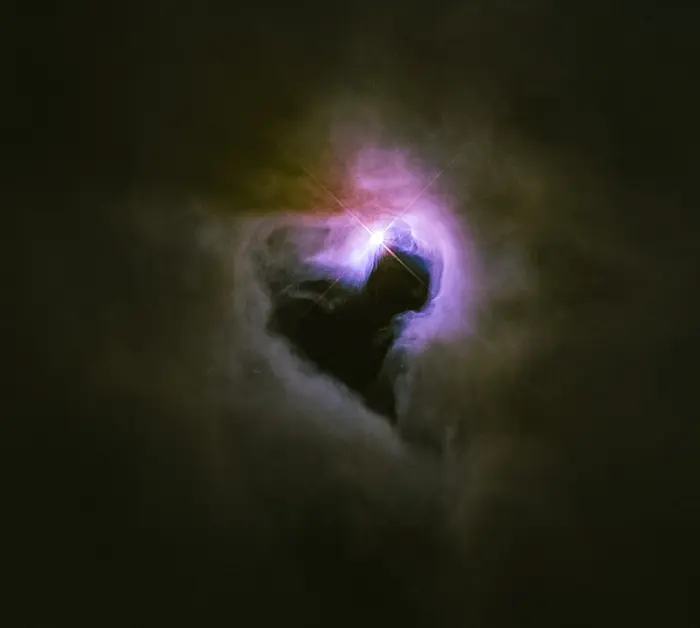
V380 Orionis and NGC 1999, image credit: NASA/ESA/Hubble Team/Keith S. Noll/Kevin M. Gill (CC BY 2.0)
Gliese 208
Gliese 208 (GJ 208) is a dwarf star of the spectral type M0.0 Ve or K7.9 V, located 37.2 light-years away. The red or orange dwarf has a mass of 0.646 solar masses and a radius of 0.601 solar radii. With a surface temperature of 3,966 K, it shines with only 8% of the Sun’s luminosity. It has an estimated age of 2.7 billion years.
The star is believed to have passed within only 5 light-years of the Sun approximately 500,000 years ago. It likely has a spectroscopic companion, one that cannot be resolved visually.
The cool dwarf star is classified as an RS Canum Venaticorum variable. With a brightness that varies between magnitudes 8.8 and 9.05, it is well below unaided eye visibility.
RS CVn variables are close binary stars with active chromospheres that produce large stellar spots. These spots cause variations in brightness with periods that closely match the binary systems’ orbital periods. The brightness of Gliese 208 varies by around a quarter magnitude with a period of 12.285 days.
GJ 208 forms a wide binary system with the red dwarf 2MASS J0536+1117, which lies at a separation of 2.6 arcminutes, corresponding to a physical distance of 0.028 light-years.
Gliese 3379
Gliese 3379 (GJ 3379) is the nearest Orion star to the solar system. It lies only 16.986 ± 0.003 light-years away. With an apparent magnitude of 11.307, it is invisible to the unaided eye.
Gliese 3379 is a red dwarf star with 23.12% of the Sun’s mass and a radius 24.57% that of the Sun. With an effective temperature of 3,284 K, it has only 0.6329% of the Sun’s energy output. The star takes 1.809 days to complete a rotation.
The red dwarf passed within only 4.08 ± 0.20 light-years of the Sun around 161,000 years ago. This is closer than the present distance of Proxima Centauri (4.2465 ly), the nearest star to Earth.
FU Orionis
FU Orionis is a binary star system located 1,360 light-years away. It has an apparent magnitude of 8.94. The star was once much fainter, shining at magnitude 16.5. In 1937, it brightened to magnitude 9.6 and has since become slightly brighter.
FU Orionis is a prototype for a class of stars called the FU Orionis variables (FUors). These are very young pre-main-sequence objects that exhibit enormous changes both in magnitude and spectral type. The dramatic brightening is believed to be caused by sudden mass transfer from an accretion disk onto the young T Tauri star.
The FU Orionis star system is composed of two components, each surrounded by a circumstellar disk. The primary component has a mass of 0.6 solar masses and the secondary, 1.2 solar masses. The spectral types of both stars are uncertain. The stars are believed to be around 2 million years old.
FU Orionis is associated with a molecular cloud catalogued as Barnard 35. The cloud is part of the larger Lambda Orionis Ring (Sh2-264), an H II region in the region of Orion’s head, marked by the star Meissa (Lambda Orionis).
UX Orionis
UX Orionis is a Herbig Ae/Be star, a young stellar object that has not yet started burning hydrogen in its core. It has the stellar classification A3ea and an estimated age of only 4.8 million years.
The star lies approximately 1,052 light-years away. It has an apparent magnitude that varies from magnitude 9.48 to 12.5. The brightness variations are caused by a circumstellar disk that occasionally obscures the star’s light.
UX Orionis is a prototype for a class of variable stars known as UX Orionis variables (UXors). Like UX Orionis, these stars show dramatic irregular variations in brightness with amplitudes greater than 2.8 magnitudes.
HD 34445
HD 34445 is a Sun-like star located 150.5 light-years away. It has the stellar classification G0 V and a surface temperature of 5,836 K. The star was discovered to host six orbiting planets, detected in 2004 and 2017. All six candidate exoplanets are significantly more massive than Earth.
A study published in 2021 only confirmed HD 34445 b, a planet with a mass at least 63% that of Jupiter. The other five planets were found to be false positives or not detected.
HD 34445 is slightly larger and more massive than the Sun. It has a mass of 1.07 solar masses and a radius of 1.38 solar radii. It shines with 2.01 solar luminosities and spins at 2.7 km/s. The star has an estimated age of 8.5 billion years.
Becklin–Neugebauer Object (BN)
The Becklin–Neugebauer Object is an object discovered by American astrophysicists Eric Becklin and Gerry Neugebauer in 1967. The object is believed to be an intermediate-mass protostar expelled from its birthplace either as a result of multi-system interaction or a supernova event. It is visible only in the infrared band. The young star is still surrounded by a circumstellar disk.
The Becklin-Neugebaur Object is the brightest object in the Kleinmann-Low Nebula (the Orion KL Nebula), the most active star forming region at the centre of the larger Orion Nebula. The nebula appears about 1 arcminute northwest of the Trapezium Cluster. Like the protostar, the nebula can only be seen at infrared wavelengths because it is surrounded by thick clouds of dust.
The protostar is considered a runaway star. It has a redshift of 11 km/s with respect to the Orion Molecular Cloud 1 (OMC1). It is thought to have been expelled from its birthplace around 500 years ago, along with at least six other compact sources, detected by the Very Large Array (VLA) in 2020.
The Becklin–Neugebauer Object lies at an approximate distance of 1,500 light-years from Earth. It has an estimated mass of 16 – 25 times that of the Sun.
Deep sky objects in Orion
Orion contains many deep sky objects visible in amateur telescopes and listed in the Messier catalogue and the Herschel 400 catalogue. It does not contain any Caldwell objects.
The Messier objects in Orion are the Orion Nebula (Messier 42), De Mairan’s Nebula (Messier 43), and the reflection nebula Messier 78.
The objects included on the Herschel 400 observing list are the planetary nebula NGC 2022, the emission nebula NGC 2024 (the Flame Nebula), the reflection nebulae NGC 1788 and NGC 1999, and the open clusters NGC 1980, NGC 2169 (the 37 Cluster), NGC 2186, and NGC 2194.
Most of these objects are part of the Orion Molecular Cloud Complex, a large complex of nebulae and young star clusters that stretches across most of the Orion constellation.
Orion Molecular Cloud Complex
The Orion Molecular Cloud Complex (or simply the Orion Complex) is a vast star-forming region located in Orion. It is one of the most active regions of star formation that can be seen in Earth’s night sky.
The Orion Complex is comprised of a large group of dark clouds, bright emission and reflection nebulae, dark nebulae, H II regions, young stars, protostars, protoplanetary discs, and young star clusters. The stars in the Orion Complex have estimated ages of up to 12 million years. The stellar nursery is hundreds of light-years across and lies between 1,000 and 1,400 light-years away.
Several parts of the OMCC are visible in binoculars and small telescopes, including the reflection nebula Messier 78, the emission nebula NGC 2024 (the Flame Nebula), and the open cluster NGC 2169 (the 37 Cluster). The bright Orion Nebula, the central point of light in Orion’s Sword, is visible even without binoculars.
The Orion Complex includes most of the well-known nebulae and star clusters in the constellation Orion, among others Barnard’s Loop, the Flame Nebula, Messier 42 and Messier 43, and the Horsehead Nebula.
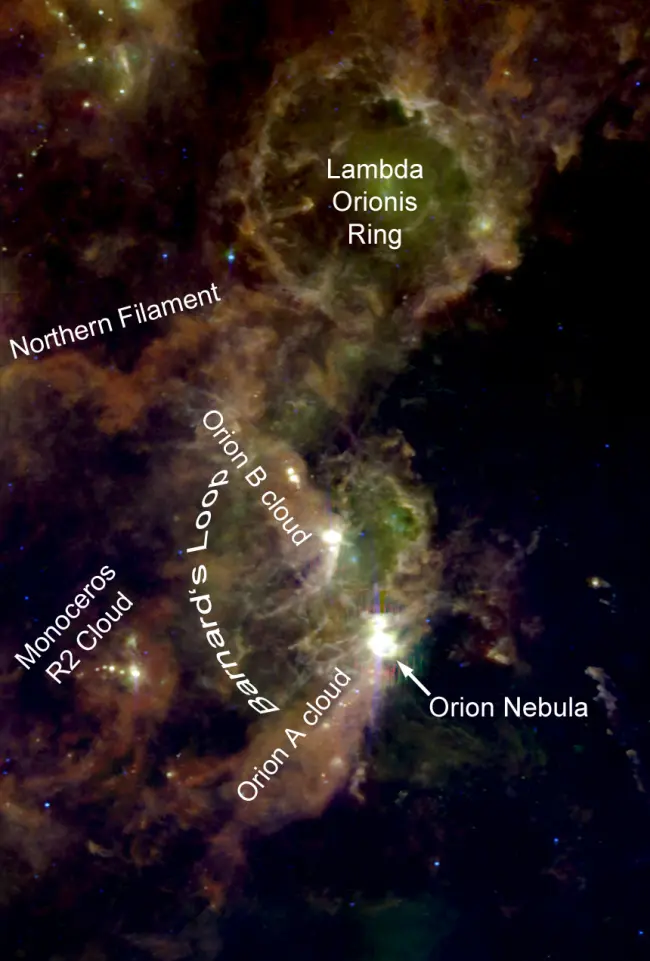
This is a labeled version of the Orion Molecular Cloud. Credit: Meli thev (CC BY-SA 4.0)
Orion Nebula – Messier 42 (M42, NGC 1976)
The Orion Nebula (M42) is a bright stellar nursery located 1,344 light years away. It is the nearest region of massive star formation to the Sun and one of the brightest nebulae in the sky. With an apparent magnitude of 4.0, it is easily visible to the unaided eye on a clear night.
The nebula appears as the slightly blurry central “star” in Orion’s Sword, south of Orion’s Belt. It is also known as the Great Nebula or the Great Orion Nebula.
The nebula has an apparent size of 60 by 65 arcminutes, corresponding to a physical diameter of 24 light years. It has a mass of almost 2,000 Suns.
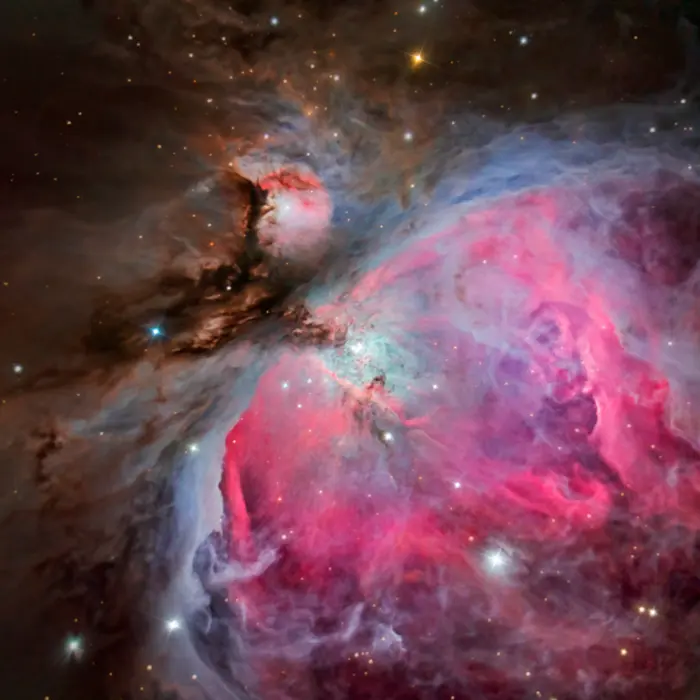
The Orion Nebula (M42), image: Wikimedia Commons/Astrocld (CC BY 4.0)
The young Trapezium Cluster, the central cluster of the Orion Nebula, is named for the asterism formed by its four brightest components. It is part of the larger Orion Nebula cluster, which contains around 2,800 stars within a region 20 light-years across.
The Orion Nebula harbours regions of ionized gas, neutral gas, dust clouds, reflection nebulae, and young stellar associations and star clusters. It is part of the larger Orion Molecular Cloud Complex.
Nicolas-Claude Fabri de Peiresc is usually credited for the discovery of the Orion Nebula. The French astronomer observed it with a refractor telescope on November 24, 1610.
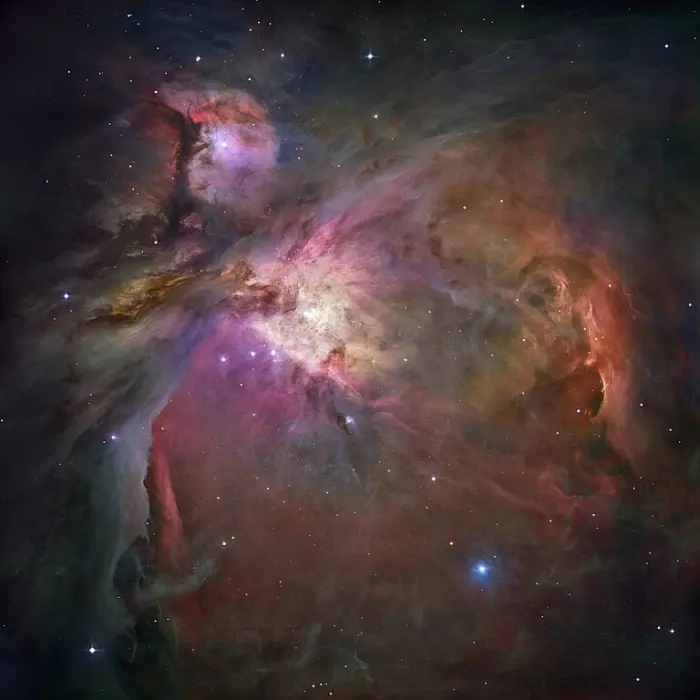
The Orion Nebula (M42) by the Hubble Space Telescope, credit: NASA, ESA, M. Robberto (Space Telescope Science Institute/ESA) and the Hubble Space Telescope Orion Treasury Project Team (PD)
However, the nebula may have been known by the Mayans of Central America. It may have been part of their “Three Hearthstones” creation myth. The astronomers Ptolemy and Galileo did not mention the object, giving rise to speculation that it may have brightened in the recent centuries.
The French astronomer and comet hunter Charles Messier observed the Orion Nebula on March 4, 1769, noting three components of the Trapezium Cluster. He included the nebula in his catalogue of deep sky objects that may be mistaken for comets in 1774.
The Orion Nebula was first imaged by the Hubble Space Telescope (HST) in 1993. It has since been observed by all the major space and ground-based telescopes, including the James Webb Space Telescope (JWST). It is one of the most studied star-forming regions in the sky.
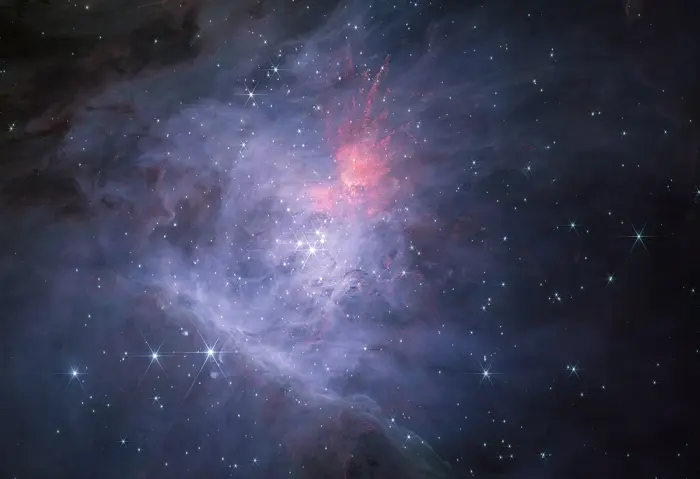
This image shows the full survey of the inner Orion Nebula and Trapezium Cluster made using the NIRCam instrument on the NASA/ESA/CSA James Webb Space Telescope. This is the short-wavelength colour composite, which reveals the nebula, its stars, and many other objects in unprecedented detail in the infrared. This young star-forming region is just a million years old and contains thousands of new stars spanning a range of masses from 40 down to less than 0.1 times the mass of the Sun. The region also contains many brown dwarfs, objects below seven percent of the mass of the Sun which are too small to start nuclear fusion in their cores. And below that, starting at roughly 13 times the mass of Jupiter, lie the planetary-mass objects. These new Webb data have revealed hundreds of such objects, floating freely in the nebula, not orbiting stars, the very smallest of which have just 60% the mass of Jupiter or two times the mass of Saturn. Image credit: NASA, ESA, CSA; Science leads and image processing: M. McCaughrean, S. Pearson (CC BY-SA 3.0 IGO)
Trapezium Cluster
The Trapezium Cluster (or the Orion Trapezium Cluster) is a young, tight open star cluster located in the centre of the Orion Nebula. The cluster lies 1,344 light-years away and has an apparent magnitude of 4.0. It is 47 arcseconds in size, corresponding to a physical radius of 10 light-years.
The Trapezium Cluster has the Bayer designation Theta1 Orionis. It was discovered by the Italian astronomer Galileo Galilei, who sketched three components of the cluster (A, C, and D) on February 4, 1617. However, Galileo did not see the surrounding nebula.
The fourth component of the Trapezium was spotted by several observers in 1673. By 1888, a total of eight components were discovered. Some of them were later discovered to be binary systems.
The Trapezium Cluster is an easy target for beginner astronomers. Six of its components can be spotted in 5-inch telescopes in good conditions.
The brightest five stars in the Trapezium Cluster emit most of the light that illuminates the surrounding nebula. They have masses between 15 and 30 times that of the Sun and will end their lives as luminous supernovae. The stars lie within 1.5 light-years of each other.
The Trapezium Cluster is easily identifiable by the asterism formed by its four brightest components, designated A, B, C and D. The brightest of these, Theta1 Orionis C, shines at magnitude 5.13 and is visible without binoculars from areas without too much light pollution. The primary component in the system, Theta1 Ori C1, is an O-type main sequence star with a mass 33 times that of the Sun and a luminosity of 204,000 Suns. The secondary, a B-type main sequence star, has a mass of 11 solar masses.
The components A and B are classified as eclipsing binary stars. As the individual components pass in front of each other during their orbit, the brightness of these systems drops.
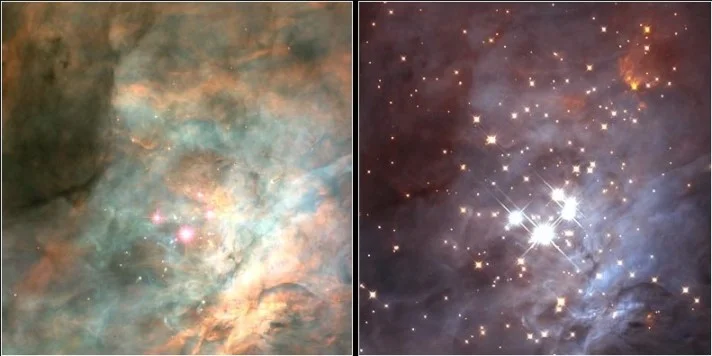
Two views of the Trapezium cluster in the Orion Nebula, from the Hubble Space Telescope. The image on the left, an optical spectrum image taken with Hubble’s WFPC2 camera, shows a few stars shrouded in glowing gas and dust. On the right, an image taken with Hubble’s NICMOS infrared camera penetrates the haze to reveal a swarm of stars as well as brown dwarfs. Credits for near-infrared image: NASA; K.L. Luhman (Harvard-Smithsonian Center for Astrophysics, Cambridge, Mass.); and G. Schneider, E. Young, G. Rieke, A. Cotera, H. Chen, M. Rieke, R. Thompson (Steward Observatory, University of Arizona, Tucson, Arizona). Credits for visible-light picture: NASA, C.R. O’Dell and S.K. Wong (Rice University) (PD)
Kleinmann-Low Nebula
The Kleinmann-Low Nebula (the Orion KL Nebula) is the most active star forming region near the centre of the Orion Nebula. It appears 1 arcminute northwest of the Trapezium Cluster and 12 arcseconds south of the Becklin-Neugebauer Object (BN).
The Kleinmann-Low Nebula contains a cluster of very young stars and protostars embedded in a molecular cloud. The stars in the nebula are still surrounded by shells of material from which they formed.
Other than the Becklin-Neugebauer Object, several compact sources have been detected in the nebula, including IRc2, a young star with more than 30 times the Sun’s mass.
The nebula is the brightest component of the Orion Molecular Cloud 1 (OMC1). It is obscured by thick dust and can only be seen in the infrared band. It was named after its discoverers, the American astronomer Douglas Kleinmann and Frank J. Low, who found it in 1967.
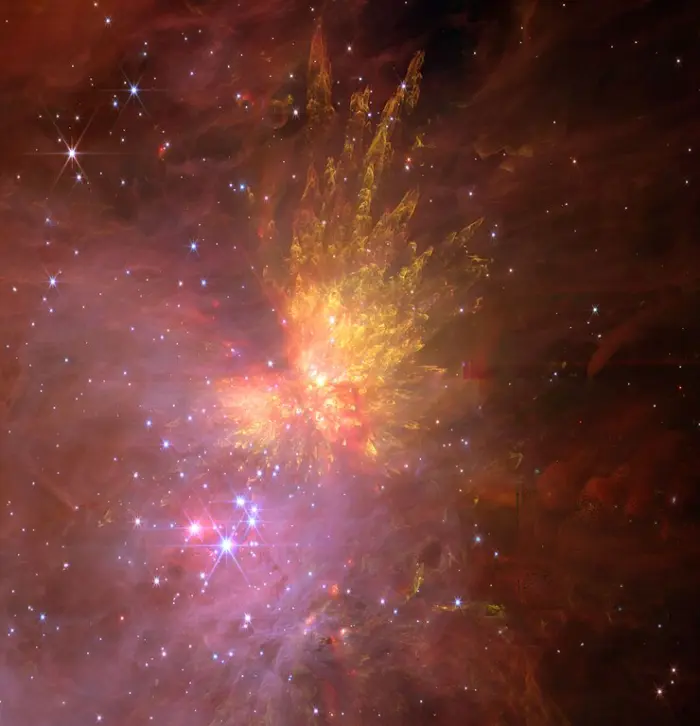
The Kleinmann–Low Nebula (KL nebula) and the Becklin–Neugebauer Object (BN object) captured by the James Webb Space Telescope (JWST), image credit: NASA/ESA/CSA JWST NIRCam; Mark McCaughrean et al. (CC BY-SA 4.0)
De Mairan’s Nebula – Messier 43 (M43, NGC 1982)
De Mairan’s Nebula (M43) is a star-forming nebula located approximately 1,300 light-years away. It has an apparent magnitude of 9.0 and an apparent size of 20 by 15 arcminutes. It is part of the larger Orion Nebula but is separated from the main nebula by a dark dust lane.
De Mairan’s Nebula is named after its discoverer, the French astronomer Jean-Jacques d’Ortous de Mairan, who noted his discovery in 1731. Charles Messier included the nebula in the Messier catalogue on March 4, 1769.
Messier 43 contains a prominent H II region about 2.1 light-years across. The region of ionized hydrogen has a luminosity of 78 Suns.
The young star system HD 37061 is mainly responsible for ionizing the nebula. The triple star system includes a spectroscopic binary star whose main component is a hot blue B-type main sequence star with about 19 times the Sun’s mass and a radius of 5.7 solar radii. The star has an effective temperature of 31,000 K and is over 26,000 times more luminous than the Sun.
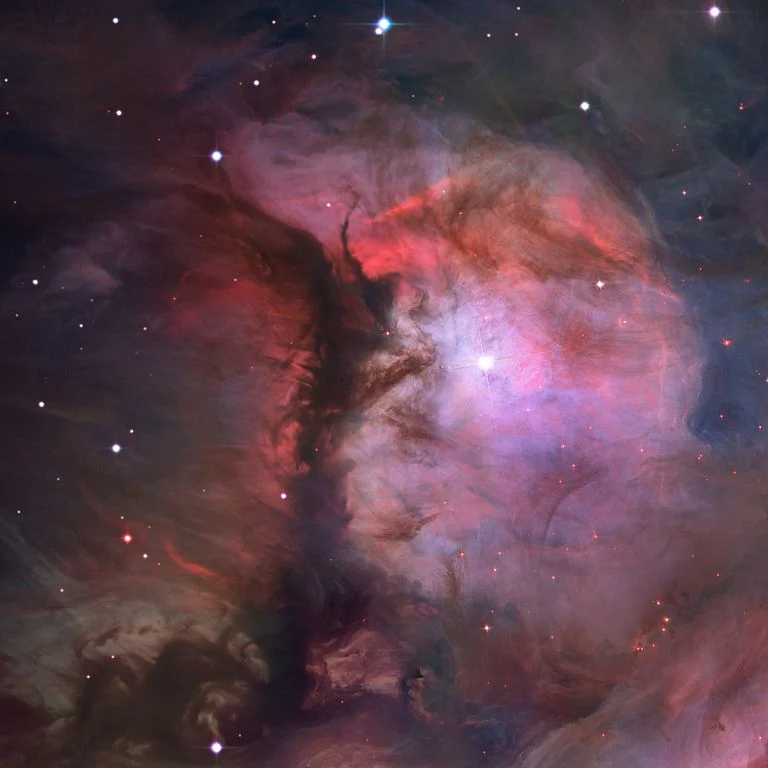
De Mairan’s Nebula (Messier 43), image: NASA, ESA, M. Robberto (Space Telescope Science Institute/ESA) and the Hubble Space Telescope Orion Treasury Project Team (PD)
Running Man Nebula (NGC 1977)
The Running Man Nebula (NGC 1977) is a reflection nebula located approximately 1,500 light-years away in the region of Orion’s Sword. It is part of the larger H II region Sh2-279. It has a radius of 7.5 light-years and is one of the most popular astrophotography targets in Orion. It appears in the same wide field of view as the Orion Nebula.
The nebula has a unique appearance that resembles the figure of a running man, which is how it got its name. It appears only 0.6 degrees north of the Orion Nebula and is the northernmost point of light in Orion’s Sword.
The Running Man Nebula is illuminated by 42 Orionis, a hot, blue young stellar object with a mass 12 times that of the Sun. 42 Orionis is a multiple-star system consisting of a spectroscopic binary star and a more distant companion. The system has an apparent magnitude of 4.59 and is visible to the unaided eye on a clear night.
The nebula itself is a more challenging target. It may be spotted in small and medium telescopes on a very clear night, but the outline of the running man is best seen photographically.
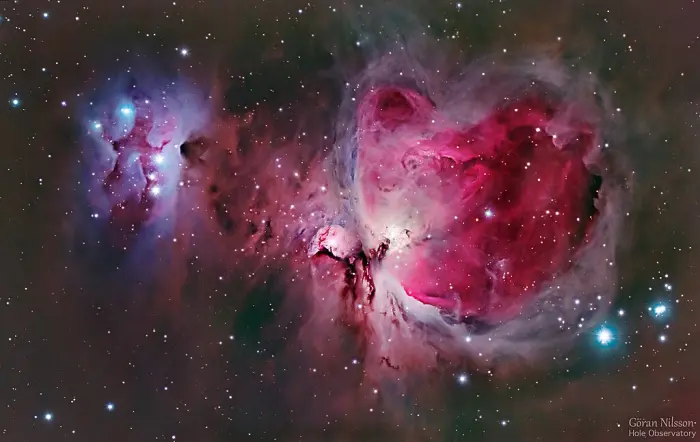
The Running Man Nebula (left) and the Orion Nebula (right), image credit: Göran Nilsson. Hole Observatory (CC BY-SA 4.0)
Messier 78 (M78, NGC 2068)
Messier 78 is a reflection nebula located approximately 1,350 light-years away in Orion. With an apparent magnitude of 8.3, it can be spotted in small telescopes, but requires good viewing conditions. The nebula has an apparent size of 8 by 6 arcminutes, corresponding to a physical radius of 5 light-years.
Messier 78 was discovered by the French astronomer Pierre Méchain in 1780. Charles Messier catalogued it as the 78th object in his catalogue.
The nebula appears at the intersection of the imaginary lines connecting Betelgeuse and Alnitak and Bellatrix and Sirius. It is the brightest in the group of reflection nebulae that includes NGC 2064, NGC 2067, and NGC 2071. These nebulae lie in the Orion B molecular cloud.
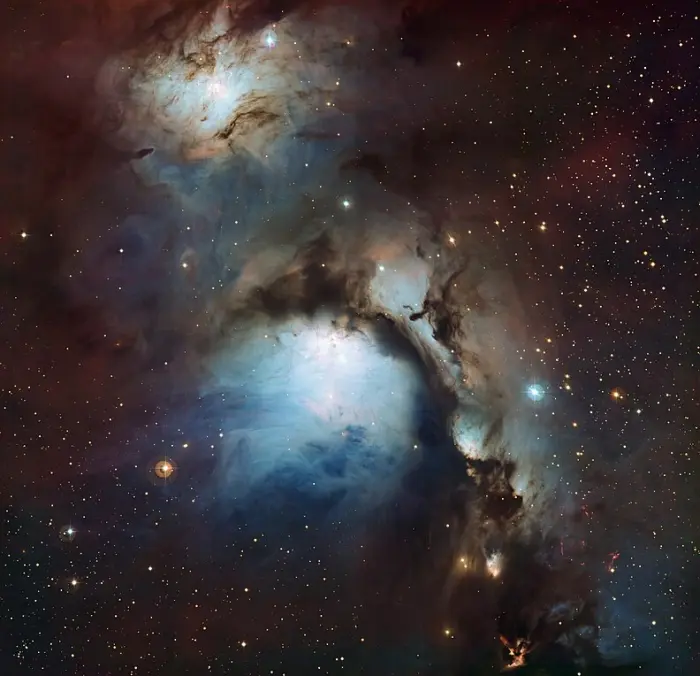
This image of the reflection nebula Messier 78 was captured using the Wide Field Imager camera on the MPG/ESO 2.2-metre telescope at the La Silla Observatory, Chile. This colour picture was created from many monochrome exposures taken through blue, yellow/green and red filters, supplemented by exposures through a filter that isolates light from glowing hydrogen gas. Image credit: ESO/Igor Chekalin (CC BY 4.0)
The nebula M78 is illuminated by the light of two hot B-type stars catalogued as HD 38563 A and HD 38563 B. The two stars shine at 10th and 11th magnitude.
In May 2024, the European Space Agency (ESA) released images of M78 captured by the Euclid space telescope. The images revealed the region in unprecedented detail and detected hundreds of thousands of objects within it for the first time. The objects include ones with sub-stellar size, which are particularly difficult to capture.
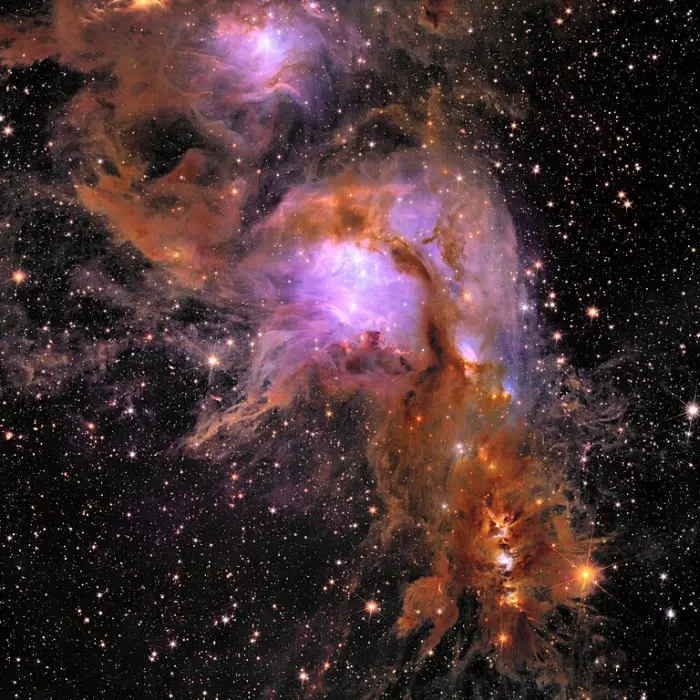
This image is released as part of the Early Release Observations from ESA’s Euclid space mission. All data from these initial observations are made public on 23 May 2024 – including a handful of unprecedented new views of the nearby Universe, this being one. This breathtaking image features Messier 78 (the central and brightest region), a vibrant nursery of star formation enveloped in a shroud of interstellar dust. This image is unprecedented – it is the first shot of this young star-forming region at this width and depth. Euclid peered deep into this enshrouded nursery using its infrared camera, exposing hidden regions of star formation for the first time, mapping its complex filaments of gas and dust in unprecedented detail, and uncovering newly formed stars and planets. This is the first time we’ve been able to see these smaller, sub-stellar sized objects in Messier 78; the dark clouds of gas and dust usually hide them from view, but Euclid’s infrared ‘eyes’ can see through these obscuring clouds to explore within. Also visible to the top of the frame is the bright nebula NGC 2071, and a third filament of star formation towards the bottom of the image (with a ‘traffic light’-like appearance). This lower region is a dark nebula producing lower-mass stars, all arranged along elongated filaments in space. Credit: European Space Agency (CC BY-SA 3.0 IGO)
NGC 2071
NGC 2071 is a reflection nebula located around 1,300 light-years away in Orion. It has an apparent size of 7 by 5 arcminutes and appears just north of the brighter nebula Messier 78. It is around 4 light-years across.
NGC 2071 was discovered by William Herschel on January 1, 1784. It is part of a larger cloud of nebulosity that also includes M78, NGC 2064 and NGC 2067.
NGC 2064
NGC 2064 is a reflection nebula located approximately 1,600 light-years away in the same region as M78. It is 1 arcminute across and has an apparent magnitude of 8.2. It was discovered by the German astronomer Heinrich Louis d’Arrest on January 11, 1864.
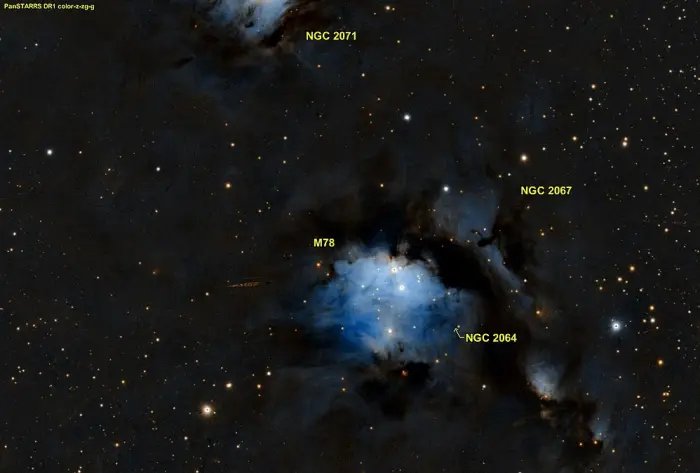
Messier 78, NGC 2071, NGC 2064 and NGC 2067, image created using the Aladin Sky Atlas software from the Strasbourg Astronomical Data Center and Pan-STARRS (Panoramic Survey Telescope And Rapid Response System) public data, credit: Donald Pelletier (CC BY-SA 4.0)
NGC 2067
NGC 2067 is another reflection nebula located in the same region as Messier 78. It has an apparent size of 8 by 3 arcminutes. It was discovered by the German astronomer Wilhelm Tempel in 1876.
The nebula lies just north of the circular dark lane of dust that frames M78.
McNeil’s Nebula
McNeil’s Nebula is a variable nebula illuminated by the reddish variable star V1647 Orionis. It was named after its discoverer, the amateur astronomer and astrophotographer Jay McNeil of Paducah, Kentucky, who discovered it with a 3-inch telescope in 2004.
The nebula lies approximately 1,600 light-years away in the same area as M78. It has an apparent magnitude of 15-16 and an apparent size of 1.3 by 0.95 arcminutes.
The cometary-type reflection nebula did not appear in any images taken before September 2003. It appeared after the young star V1647 Orionis experienced an outburst. The nebula is visible in images taken in 1966, but not in those obtained between 1951 and 1991.
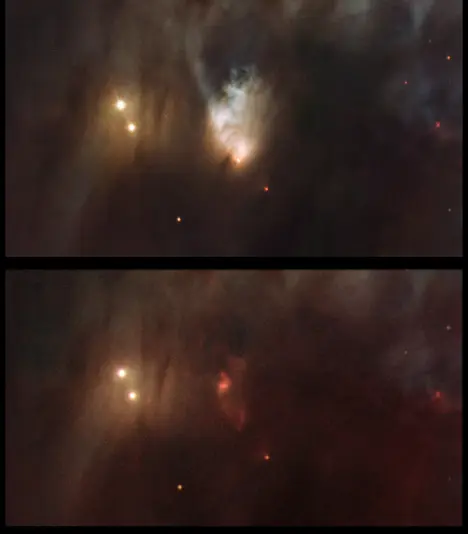
In these images we compare a colour picture of the Messier 78 region taken in 2006 with the 4-metre Mayall telescope at Kitt Peak, Arizona (below) with a new image that was captured using the Wide Field Imager camera on the MPG/ESO 2.2-metre telescope at the La Silla Observatory, Chile (above). The bright, but highly variable, fan-shaped structure, a feature first spotted by amateur astronomer Jay McNeil in early 2004, is almost completely invisible in the older image but very prominent in the new picture. Image credit: ESO/T. A. Rector/University of Alaska Anchorage, H. Schweiker/WIYN and NOAO/AURA/NSF and Igor Chekalin (CC BY 4.0)
Flame Nebula (NGC 2024)
The Flame Nebula (NGC 2024) is an emission nebula located around 1,350 light-years away in Orion. It has an apparent magnitude of 10. The nebula appears near Alnitak, the easternmost star of Orion’s Belt. It is part of the Orion B cloud within the larger Orion Molecular Cloud Complex.
The Flame Nebula has an apparent size of 30 arcminutes, corresponding to a physical radius of 6 light-years. It is not physically associated with Alnitak.
The nebula contains an open cluster of young stars with at least one hot, luminous O-type star, whose intense ultraviolet light is responsible for ionizing the nebular gas and making it glow. The star lies in the eastern part of the nebula.
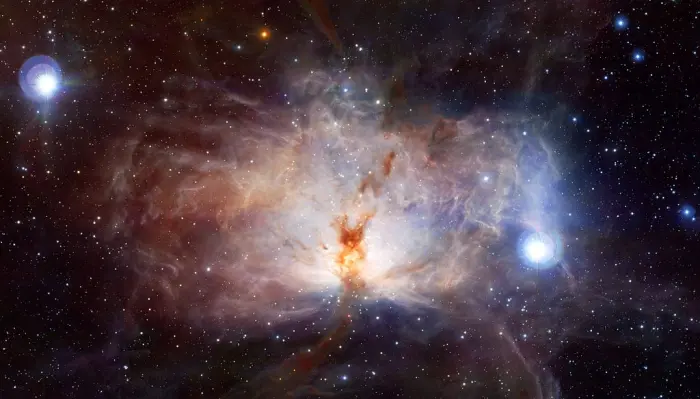
The Flame Nebula (NGC 2024), image credit: ESO/J. Emerson/VISTA. Acknowledgment: Cambridge Astronomical Survey Unit (CC BY 4.0)
Most stars in the young open cluster (86%) are still surrounded by circumstellar disks. Observations with the Chandra X-ray Observatory have revealed several hundred cluster members. The cluster is believed to contain a total of 800 stars.
Observations with the Atacama Large Millimeter/submillimeter Array (ALMA) in 2020 revealed that the stars in the eastern portion of the nebula have an estimated age of only 0.2 – 0.5 million years, while those on the western side are around 1 million years old.
The Flame Nebula was discovered by William Herschel on January 1, 1786.
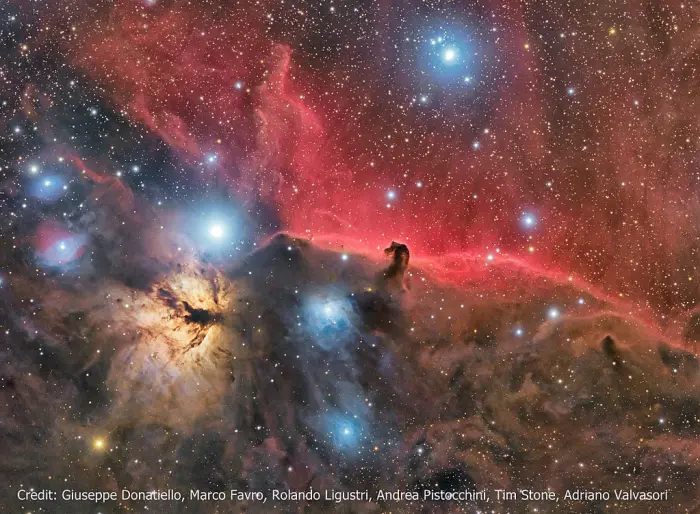
The Flame and Horsehead nebulae, credit: Giuseppe Donatiello, Marco Favro, Rolando Ligustri, Andrea Pistocchini, Tim Stone, Adriano Valvasori (CC0 1.0)
Horsehead Nebula
The Horsehead Nebula is a famous dark nebula located approximately 1,375 light-years away in the region of Orion’s Belt. The nebula is catalogued as Barnard 33 (B33) in the Barnard Catalogue of Dark Markings in the Sky, compiled by the American astronomer Edward Emerson Barnard in 1919.
E. E. Barnard described the nebula as, “Dark mass, diam. 4’, on nebulous strip extending south from ζ Orionis.” The nebula appears just south of Alnitak, the easternmost star Orion’s Belt. It lies in the same region of the sky as the Flame Nebula, the reflection nebula IC 435, and the emission and reflection nebula NGC 2023.
The Horsehead Nebula has a radius of 3.5 light-years. It is silhouetted against the bright emission nebula IC 434, which lies in the background. The nebula is called Horsehead because the shape formed by its dark clouds and gases resembles that of the head of a horse.
The Horsehead Nebula was discovered by the Scottish astronomer Williamina Fleming on a photographic plate at the Harvard College Observatory in 1888. The nebula has been captured by most major space telescopes, including Hubble, James Webb, and Euclid.
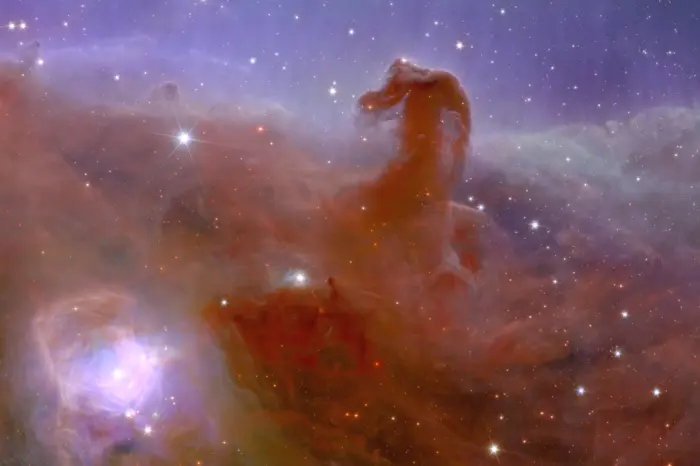
The Horsehead Nebula captured by the Euclid telescope, image credit: ESA/Euclid/Euclid Consortium/NASA image processing by J.-C. Cuillandre (CEA Paris-Saclay) G. Anselmi (CC BY-SA 3.0 IGO)
IC 434
IC 434 is a large emission nebula located around 1,260 light-years away. It was discovered by William Herschel on February 1, 1786. The H II region is the inner portion of the larger shell of neutral hydrogen that spans an area 2 by 4 degrees across, corresponding to physical dimensions of 42 by 85 light-years across. The neutral hydrogen shell is catalogued as GS206-17-13.
IC 434 itself has an apparent size of 60 by 40 arcminutes, which at that distance yields a physical diameter of about 26 light-years. The nebula has a mass of around 100 Suns. It is ionized by the ultraviolet light of the massive stars in the Sigma Orionis system.
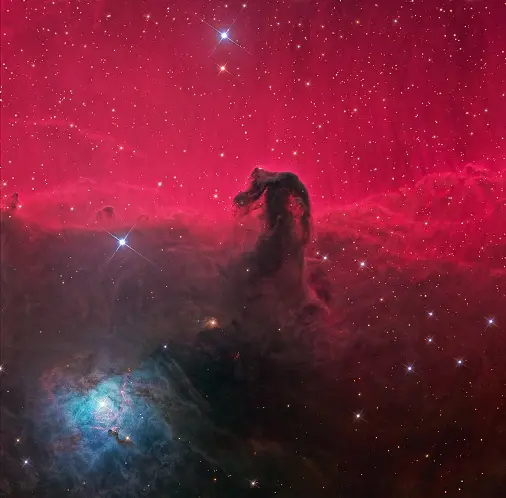
Horsehead Nebula (also known as Barnard 33 in emission nebula IC 434) is a dark nebula in the constellation Orion. The image is a frame mosaic taken with 5 different filters, standard Red – Green – Blue with details enhanced with narrowband data of Hydrogen-alpha (Hα) and O III. The Hα was color-mapped to red and the O III to teal. So it is a representative color image consisting of over 900 minutes of exposure time. Image: Ken Crawford (CC BY-SA 3.0)
NGC 2023
NGC 2023 is an emission and reflection nebula located approximately 1,300 light-years away. It was discovered by William Herschel on January 6, 1785. Stretching 10 arcminutes across, it is one of the largest reflection nebulae in the sky.
NGC 2023 is found about 15 arcminutes northeast of the Horsehead Nebula. It is part of the Orion B molecular cloud (Lynds 1630), which also contains the Flame Nebula (NGC 2024).
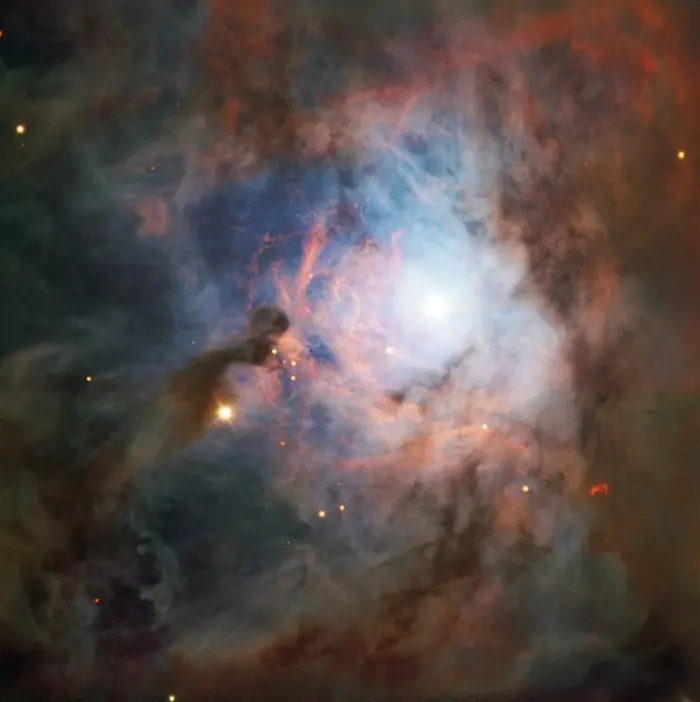
This image, from ESO’s Very Large Telescope, shows a reflection nebula nestled at the heart of the constellation — NGC 2023. Located close to the well-known Horsehead and Flame Nebulae, NGC 2023 is one of the largest reflection nebulae in the sky. The image was taken with the VLT’s FORS (FOcal Reducer and Spectrograph) instrument as part of the ESO Cosmic Gems programme. Credit: ESO (CC BY 4.0)
The nebula reflects the light of the young B-type Herbig Ae/Be star HD 37903. The region around the central pre-main-sequence star is a source of fluorescent molecular hydrogen emission.
The nebula harbours newly formed stars still embedded in their birth clouds. Observations with the Spitzer Space Telescope have revealed 21 embedded infrared sources (young stars and protostars) in NGC 2023. HD 37093 is the most massive of the young stars within the nebula.
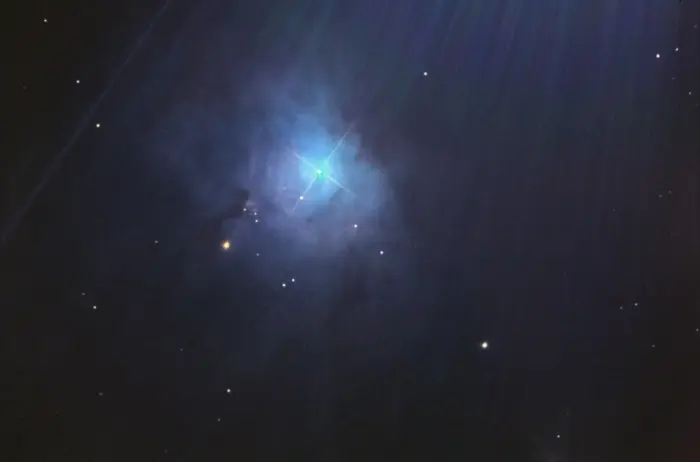
This image of NGC 2023 was taken as part of Advanced Observing Program (AOP) program at Kitt Peak Visitor Center during 2014. Credit: KPNO/NOIRLab/NSF/AURA/Adam Block (CC BY 4.0)
Barnard’s Loop
Barnard’s Loop (Sh2-276) is a large emission nebula in the constellation Orion. It lies either 518 or 1,434 light-years away based on the recent estimates. This corresponds to a physical size of either around 100 or 300 light-years across. The nebula has an apparent magnitude of 5 and an apparent size of 10 degrees. It covers a sizeable portion of the Orion constellation.
Barnard’s Loop appears as a large arc centred on the region of Orion’s Nebula. It is believed to be ionized by the hot young stars in M42.
The nebula is believed to have been produced by a supernova event that occurred around 2 million years ago. The same supernova may have expelled several runaway stars – AE Aurigae in the constellation Auriga, Mu Columbae in Columba, and 53 Arietis in Aries – from their birthplace.
Barnard’s Loop is named after the American astronomer and astrophotography pioneer Edward Emerson Barnard, who photographed it in 1894.
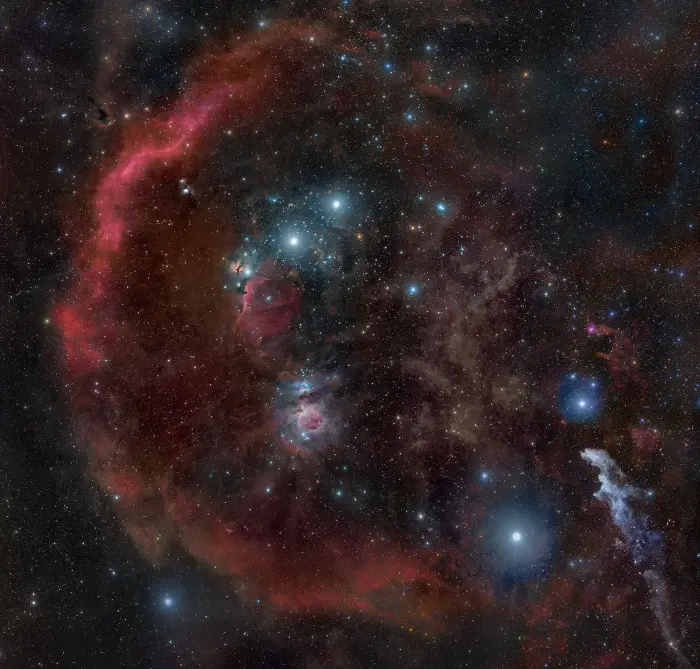
Barnard’s Loop (Sh2-276), image credit: Rogelio Bernal Andreo (CC BY-SA 3.0)
NGC 2022
NGC 2022 is a planetary nebula located 8,210 light-years away. It has an apparent magnitude of 11.6 and an apparent size of 28 arcseconds, with a halo that extends out to 40 arcseconds.
The nebula appears in the region of Orion’s head, about two thirds of the way from Betelgeuse to Meissa. It is visible in medium telescopes as a small patch of light. It may be spotted in small telescopes with an OIII filter, but it only appears as a fuzzy star.
NGC 2022 is a double-shell planetary nebula, with a brighter inner shell and a more shadowy outer shell. The inner shell has a radius of around 0.326 light-years and is expanding at 28 km/s. The outer shell is almost circular and is expanding more slowly. It is composed of material ejected from the central star at an earlier stage of evolution, when it was on the asymptotic giant branch.
The central star shines at magnitude 15.92. It has an effective temperature of 122,000 K. Even though it has a radius only 6.55% that of the Sun it is around 852 times more luminous than our star.
NGC 2022 was discovered by William Herschel on December 28, 1785.
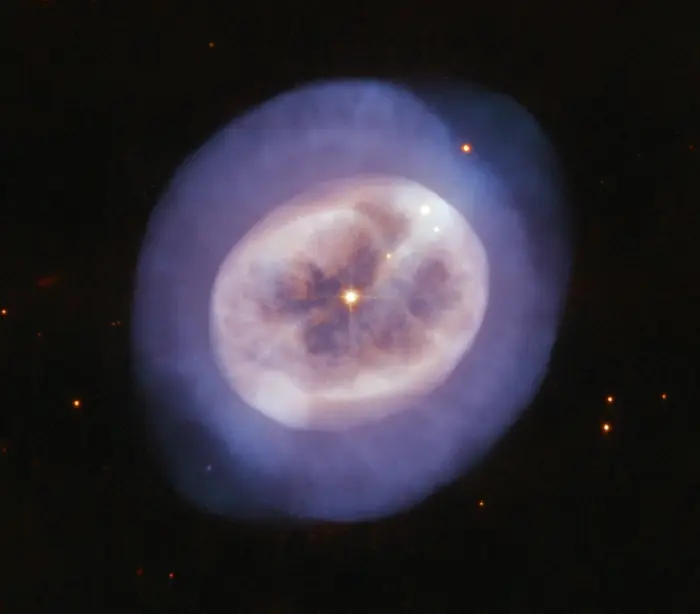
Although it looks more like an entity seen through a microscope than a telescope, this rounded object, named NGC 2022, is certainly no alga or tiny, blobby jellyfish. Instead, it is a vast orb of gas in space, cast off by an ageing star. The star is visible in the orb’s centre, shining through the gases it formerly held onto for most of its stellar life. When stars like the Sun grow advanced in age, they expand and glow red. These so-called red giants then begin to lose their outer layers of material into space. More than half of such a star’s mass can be shed in this manner, forming a shell of surrounding gas. At the same time, the star’s core shrinks and grows hotter, emitting ultraviolet light that causes the expelled gases to glow. This type of object is called, somewhat confusingly, a planetary nebula, though it has nothing to do with planets. The name derives from the rounded, planet-like appearance of these objects in early telescopes. Image credit: ESA/Hubble & NASA, R. Wade (PD)
37 Cluster (NGC 2169)
NGC 2169 is an open cluster located approximately 3,600 light-years away. It is popularly known as the 37 Cluster because its brightest stars form the letter 37. The cluster has an apparent magnitude of 5.9 and is 7 arcminutes across. It is composed of the open clusters Collinder 38 and Collinder 83.
The 37 Cluster was discovered by William Herschel on October 12, 1782. It may have been observed by Italian astronomer Giovanni Battista Hodierna before 1654.
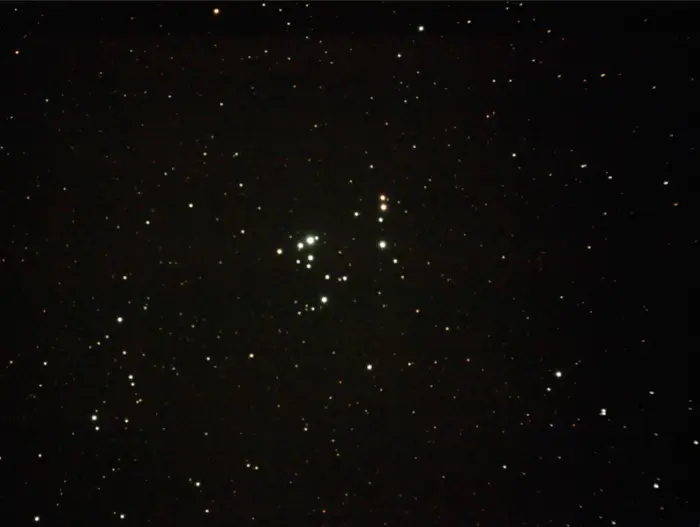
The 37 Cluster (NGC 2169), image credit: Wikimedia Commons/ScottRak (CC BY-SA 3.0)
Monkey Head Nebula (NGC 2174)
The Monkey Head Nebula (NGC 2174) is an emission nebula located approximately 6,400 light-years away in the northern part of Orion, near the border with Gemini. It is associated with the young open cluster NGC 2175 (Collinder 84). The nebula has an apparent visual magnitude of 6.8 and an apparent size of 40 arcminutes.
NGC 2174 was discovered by the French astronomer Édouard Stephan on February 6, 1877. The nebula’s gas and dust are carved and shaped by the high energy radiation from the stellar winds of the young stars formed in the region.
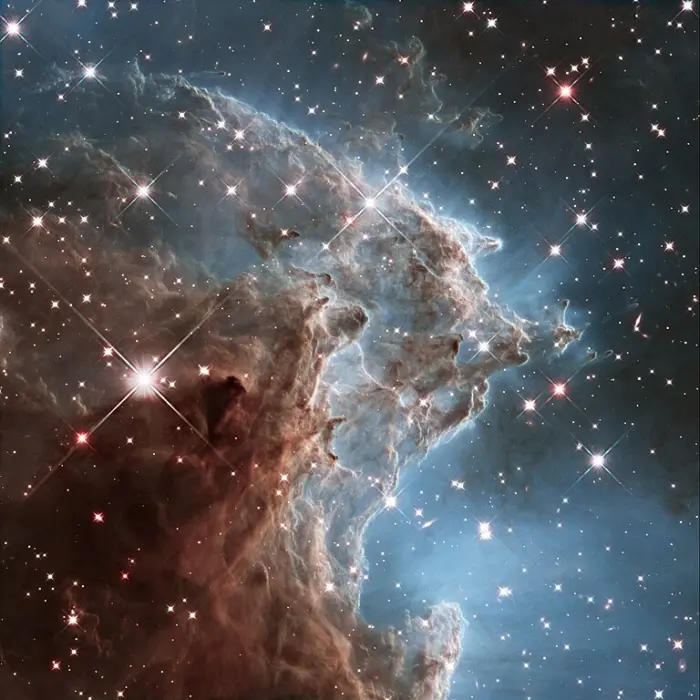
The Monkey Head Nebula (NGC 2174) by the Hubble Space Telescope (HST) in infrared, credit: NASA, ESA, and the Hubble Heritage Team (STScI/AURA) (CC BY 4.0)
NGC 1788
NGC 1788 is a reflection nebula located approximately 1,300 light-years away. Nicknamed the Cosmic Bat, it has an apparent magnitude of 9.0 and an apparent size of 8 arcminutes. It is illuminated by the young stars in its central region. Even though these stars are mostly shrouded in clouds of dust, their strong stellar winds are responsible for shaping the nebula.
NGC 1788 is flanked by a dark nebula on its southwestern border. The dark nebula is catalogued as Lynds 1616 and is believed to be part of NGC 1788.
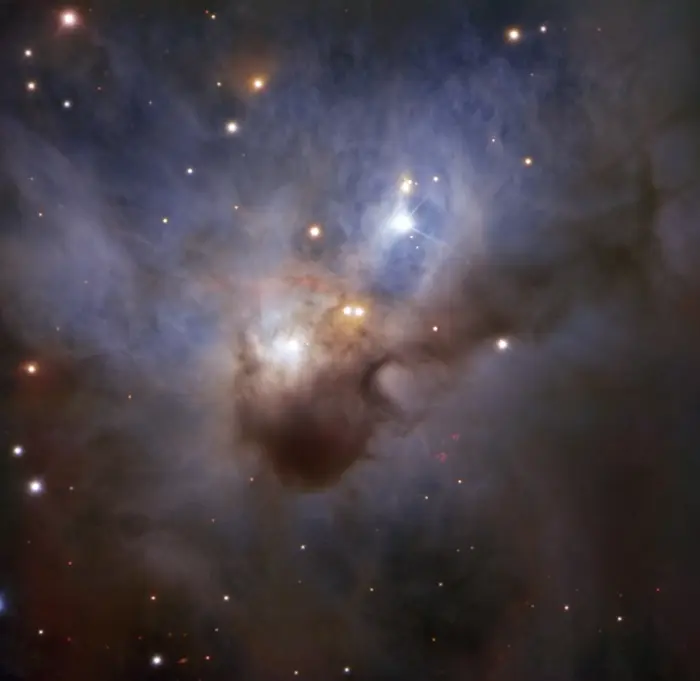
This image was obtained with the wide-field view of the Mosaic camera on the Mayall 4-meter telescope at Kitt Peak National Observatory. NGC 1788 is an unusual reflection nebula (bluish white at the center of the image) surrounded by a glowing red ring of hydrogen gas. The stars inside the nebula are only about a million years old, which is very young compared to most stars. The ring of glowing hydrogen gas is energized by nearby hot, massive stars not visible in the image. Image credit: T.A. Rector (University of Alaska Anchorage), H. Schweiker (WIYN and NOIRLab/NSF/AURA) & S. Pakzad (NOIRLab/NSF/AURA) (CC BY 4.0)
NGC 1980
NGC 1980 (Collinder 72) is an open star cluster located 1,793 light-years away. With an apparent magnitude of 2.5, it is visible without binoculars. The cluster has an apparent size of 14 arcminutes. It is sometimes called the Lost Jewel of Orion.
The cluster is associated with an emission nebula. It surrounds the star system Iota Orionis (Hatysa), the southernmost point of light in the Sword of Orion.
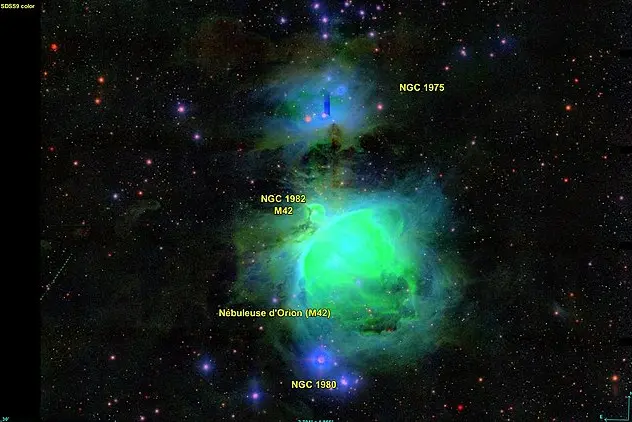
NGC 1980, image created using the Aladin Sky Atlas software from the Strasbourg Astronomical Data Center and SDSS (Sloan Digital Sky Survey) public data. Credit: Donald Pelletier (CC BY-SA 4.0)
Cosmic Keyhole (NGC 1999)
NGC 1999 is a reflection nebula illuminated by the pre-main-sequence star V380 Orionis. It has an apparent size of 1.5 arcminutes and a radius of about 0.3 light-years. It lies 1,500 light-years away.
The nebula has a vast hole in its centre whose origin is uncertain. Astronomers have speculated that the hole was created by the intense radiation from a nearby star or by jets of gas from the young stars in the V380 Orionis system.
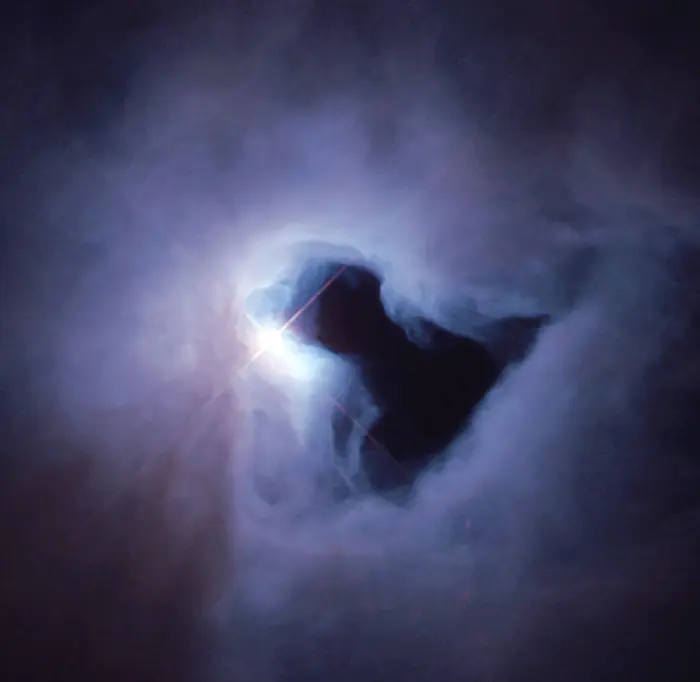
The WFPC2 image of NGC 1999 shows a remarkable jet-black cloud near its center, resembling a letter T tilted on its side, located just to the right and lower right of the bright star. This dark cloud is an example of a “Bok globule,” named after the late University of Arizona astronomer Bart Bok. The globule is a cold cloud of gas, molecules, and cosmic dust, which is so dense it blocks all of the light behind it. In the Hubble image, the globule is seen silhouetted against the reflection nebula illuminated by V380 Orionis. Astronomers believe that new stars may be forming inside Bok globules, through the contraction of the dust and molecular gas under their own gravity. Credit: NASA and The Hubble Heritage Team (STScI) (PD)
NGC 2186
NGC 2186 is an open cluster with an apparent magnitude of 8.7. It appears south of the imaginary line connecting Betelgeuse in Orion and the bright Rosette Nebula (NGC 2244) in Monoceros. The cluster was discovered by William Herschel on January 27, 1786. It has an apparent size of 5 arcminutes.
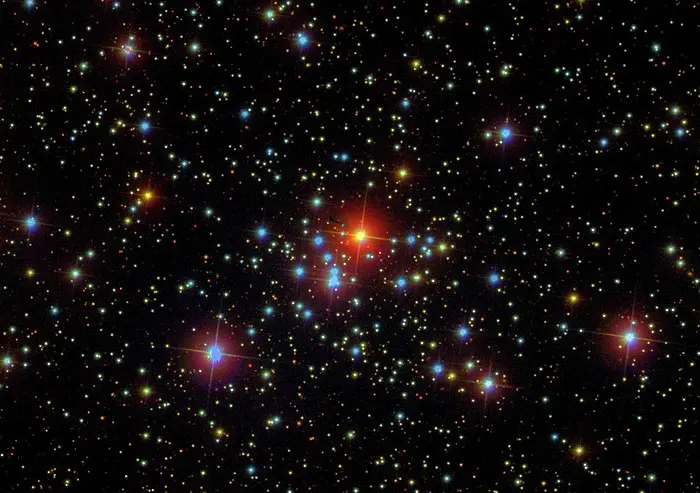
NGC 2186, credit: Sloan Digital Sky Survey (CC BY 4.0)
NGC 2194
NGC 2194 is an open cluster located approximately 12,320 light-years away. It appears in the region of Orion’s outstretched hand, about halfway between Betelgeuse in Orion and Alhena in Gemini. The star cluster has an apparent magnitude of 8.5 and an apparent size of 9 arcminutes.
NGC 2194 contains 149 stars down to 15th magnitude. Its brightest member shines at magnitude 10.26.
NGC 2194 has an estimated age of 330 million years. It was discovered by William Herschel on February 11, 1784.
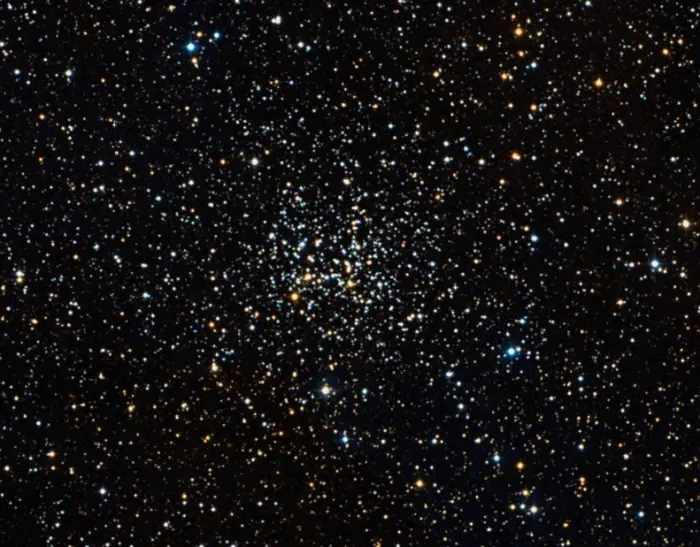
NGC 2194, image credit: ESO/Digitized Sky Survey 2 (CC BY 4.0)
HH 1/2
HH 1 and HH 2 were the first Herbig-Haro objects to be recognized as such. They lie approximately 1,500 light-years away in Orion. They appear near the reflection nebula NGC 1999 (the Cosmic Keyhole), just south of Orion’s Sword.
Herbig-Haro objects are bright knots of nebulosity associated with young stellar objects. They are typically found in star-forming regions. These objects form when high-speed jets ejected by very young stars collide with the interstellar medium, creating shock waves that lead to the ionization of the surrounding gas.
Herbig-Haro objects were first observed by the American astronomer Sherburne Wesley Burnham in the late 19th century. Burnham found them while studying the star T Tauri and identified them as a type of emission nebulae.
Herbig-Haro objects are named after the American astronomer George Herbig and Mexican astronomer Guillermo Haro, the first researchers to study them in detail. Herbig and Haro studied star formation processes independently and recognized that these objects were closely associated with the early stages of star formation.
HH 1/2 are among the brightest Herbig-Haro objects in the sky. They consist of two bright bow shocks separated by about 1.1 light-years, or 2.5 arcminutes in the sky. The bow shocks move in a bipolar flow away from a central source. Observations with the Hubble Space Telescope in 2002 revealed that some of the structures within HH 1 are moving at speeds of more than 400 km/s.
HH 1 and HH 2 were discovered by George Herbig in 1951 and Guillermo Haro in 1952.
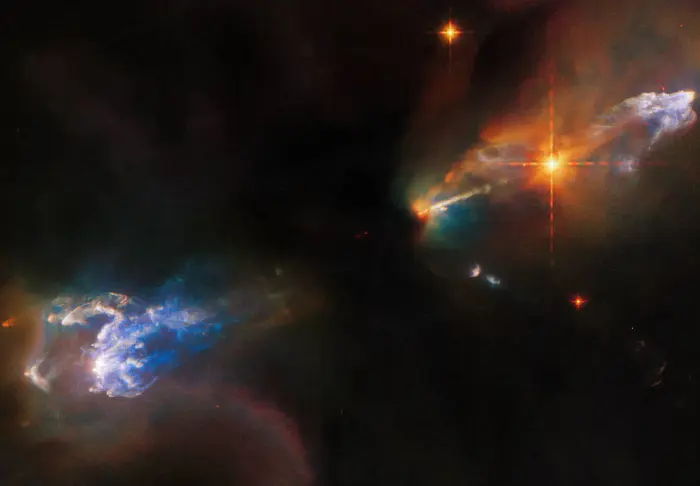
The lives of newborn stars are tempestuous, as this image of the Herbig–Haro objects HH 1 and HH 2 from the NASA/ESA Hubble Space Telescope depicts. HH 1 is the luminous cloud above the bright star in the upper right of this image, and HH 2 is the cloud in the bottom left. While both Herbig–Haro objects are visible, the young star system responsible for their creation is lurking out of sight, swaddled in the thick clouds of dust at the centre of this image. However, an outflow of gas from one of these stars can be seen streaming out from the central dark cloud as a bright jet. Meanwhile, the bright star between that jet and the HH 1 cloud was once thought to be the source of these jets, but it is now known to be an unrelated double star that formed nearby. This scene from a turbulent stellar nursery was captured with Hubble’s Wide Field Camera 3 using 11 different filters at infrared, visible, and ultraviolet wavelengths. Image credit: ESA/Hubble & NASA, B. Reipurth, B. Nisini (CC BY 4.0)
Lambda Orionis Ring (Angelfish Nebula)
The Lambda Orionis Ring (Sharpless 264) is an H II region and a molecular cloud located around 1,400 light-years away in the northern part of the Orion Molecular Cloud Complex. The nebula is named after the multiple star system Lambda Orionis (Meissa), the brightest point of light in the region. It is sometimes also known as the Angelfish Nebula.
The vast molecular ring is believed to have been produced by a supernova event. It surrounds the young Lambda Orionis Cluster (Collinder 69), a magnitude 2.8 open cluster with an estimated age of only 5 million years. Meissa is the brightest member of the cluster.
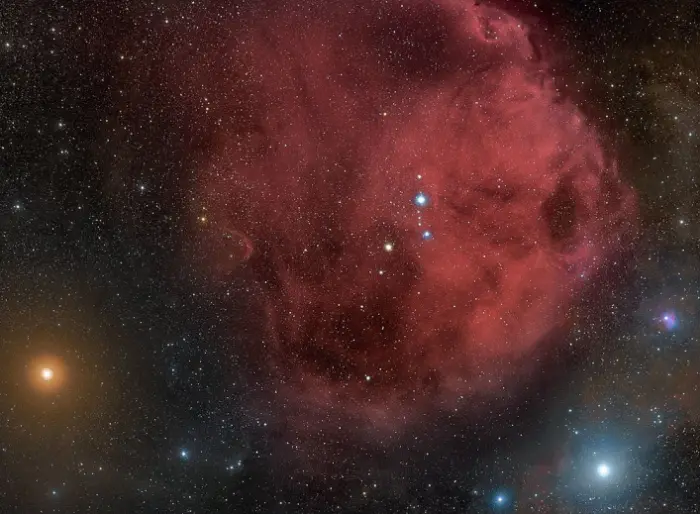
The region around Lambda Orionis (cropped from larger image), credit: Rogelio Bernal Andreo (CC BY-SA 4.0)
Raspberry Nebula (Sh2-263)
The Raspberry Nebula is an emission nebula located north and a little west of Bellatrix. The H II region is also catalogued as LBN 867. It is ionized by the light of the hot blue main sequence star HD 34989. The Simbad database lists the star as a member of the open cluster Collinder 69 (the Lambda Orionis Cluster). The reflection nebula vdB 38, which appears in the same field of view, reflects the star’s blue light.
The star has an apparent magnitude of 5.80 and is faintly visible to the unaided eye in exceptionally good conditions. It lies approximately 1,700 light-years away. With a mass of 12.1 solar masses, it is a supernova candidate.
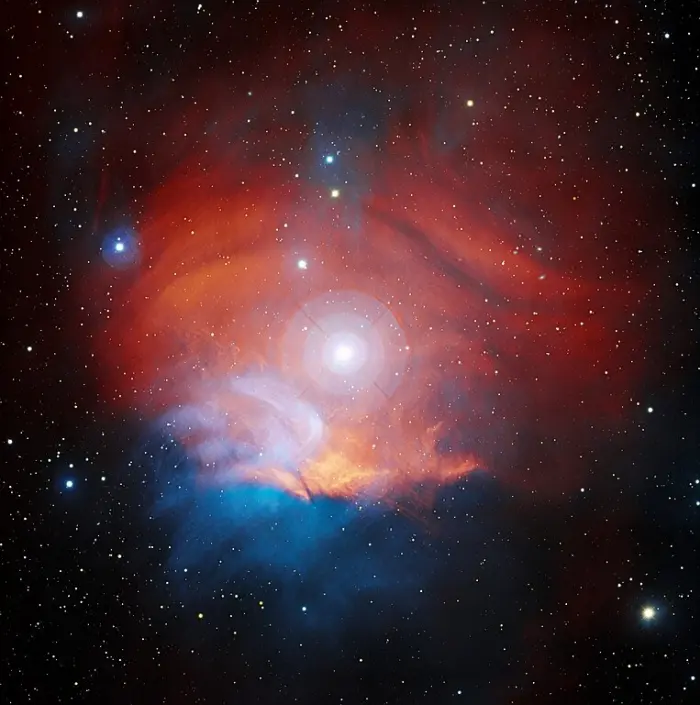
Observing the night sky has never been so delightful as with this image of LBN 867, the Raspberry Nebula. Captured here by the Nicholas U. Mayall 4-meter Telescope using the Mosaic-3 detector at Kitt Peak National Observatory (KPNO), a Program of NSF’s NOIRLab, this nebula is located in the constellation Orion. LBN 867’s overall structure, though, is more like an onion than a raspberry: it hosts three different celestial objects in one! The characteristic red bloom of LBN 867 is an emission nebula. It glows as a result of the ionization of hydrogen gas by the light from the star HD 34989. From the center of the image, this main sequence star shines prominently, though it is about as bright as the planet Uranus as seen from Earth. The last object is hidden in plain sight. Notice the subtle bluish glow around HD 34989? This is the reflection nebula vdB 38, which reflects the blue-white light of its host star off local interstellar dust. Combined, the nebulae and star become a cosmic treat for any keen astronomer. Image credit: KPNO/NOIRLab/NSD/AURA/T.A. Rector (University of Alaska Anchorage/NSF’s NOIRLab) Image processing: T.A. Rector (University of Alaska Anchorage/NSF’s NOIRLab), M. Zamani (NSF’s NOIRLab) & D. de Martin (NSF’s NOIRLab) (CC BY 4.0)
NGC 1924
NGC 1924 is a barred spiral galaxy that appears west of the Orion Nebula, about halfway between Alnitak and Rigel. It lies approximately 143 million light-years away. It has an apparent magnitude of 13.24 and an apparent size of 1.6 by 1.2 arcminutes.
The galaxy was discovered by William Herschel on October 5, 1785.
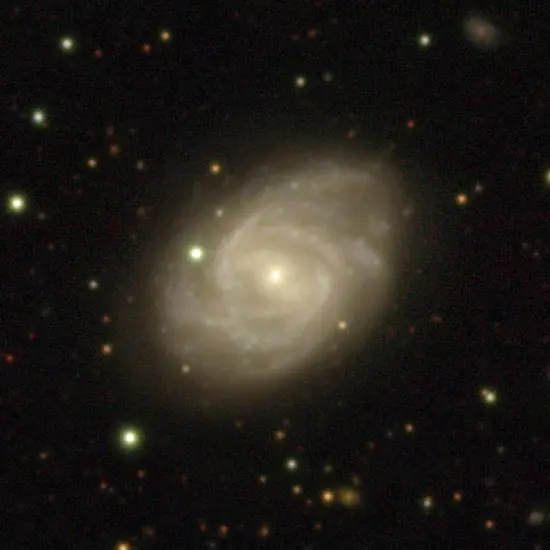
NGC 1924, image credit: Legacy Surveys/D. Lang (Perimeter Institute), NERSC (CC BY-SA 4.0)
NGC 2110
NGC 2110 is a lenticular galaxy located 120 million light-years away. It appears north-northeast of Saiph. It has an apparent magnitude of 13.5 and an apparent size of 1.7 by 1.3 arcminutes.
The galaxy has a diameter of about 90,000 light-years. It has an active galactic nucleus (AGN) with a supermassive black hole and is classified as a Seyfert galaxy.
NGC 2110 was discovered by William Herschel on the same day as NGC 1924, October 5, 1785.
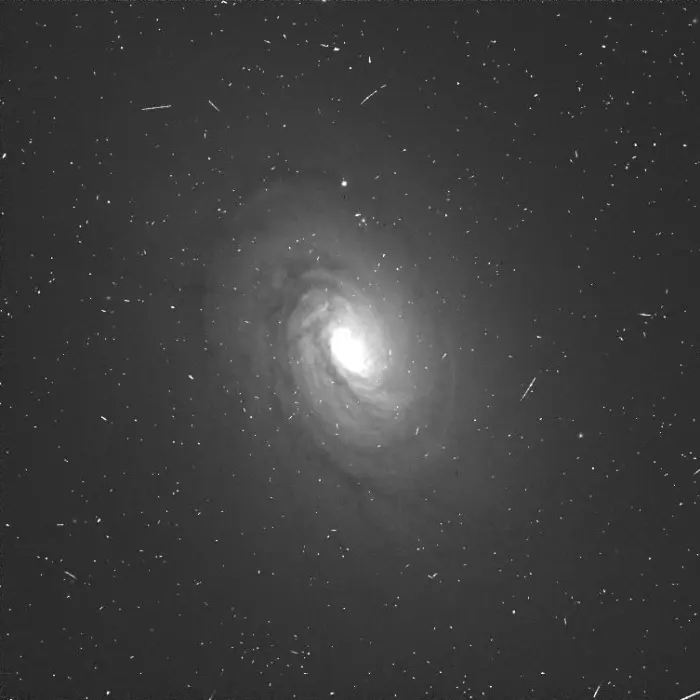
NGC 2110 by the Hubble Space Telescope (HST), image: NASA/ESA and Hubble (PD)
NGC 1819
NGC 1819 is a lenticular galaxy located approximately 197.4 million light-years away in Orion. It appears in the region west of Bellatrix. It has an apparent magnitude of 13 and an apparent size of 0.987 by 0.592 arcminutes.
The galaxy was discovered by American astronomer Lewis A. Swift on December 26, 1885. It is a gas-rich galaxy that contains a circumnuclear ring, a site of active star formation.
A supernova, SN 2005el, was detected in the galaxy on September 19, 2005. It was classified as a Type Ia supernova. At the time of discovery, it had an apparent visual magnitude of 18.7.
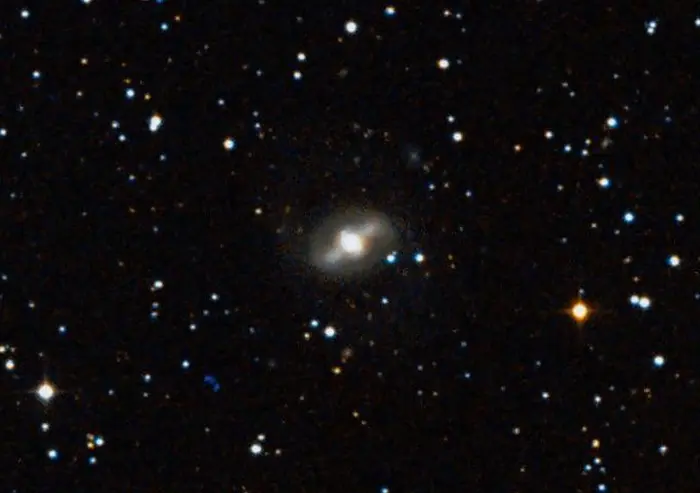
NGC 1819, image credit: ESO/Digitized Sky Survey 2 (CC BY 4.0)
Lynds 1641
Lynds 1641 is a dark cloud within the larger Orion Molecular Cloud Complex. It is a site of star formation and harbours over a thousand young stellar objects. The cloud lies between 1,249 and 1,477 light-years away.
The northern end of Lynds 1641 is connected to the Orion Nebula. Astronomers frequently study the star formation in the cloud to see how new stars are formed in an environment that is very different to that in the Orion Nebula. Unlike M42, the cloud does not contain massive, luminous O- and B-type stars.
Lynds 1641 is associated with other nebulae in the vicinity, including NGC 1999, HH 1/2, IC 429, and IC 430.
Abell 520
Abell 520 is a cluster of galaxies located at a co-moving distance of 2,645 million light-years away. It occupies 25 arcminutes of the sky in the region of Pi Orionis and Orion’s Shield.
The galaxy cluster has been nicknamed the Train Wreck Cluster because of its chaotic appearance. It contains an unusual substructure believed to be the result of a major merger. The substructure was detected with the Canada-France-Hawaii-Telescope (CFHT) in 2007.
Abell 520 was formed from a collision of massive galaxy clusters. Observations with the Wide Field Planetary Camera 2 on the Hubble Space Telescope (HST) helped astronomers map the dark matter in the cluster. Clumps of dark matter were found in regions where there were very few galaxies, confirming an earlier discovery of a dark core in the cluster.
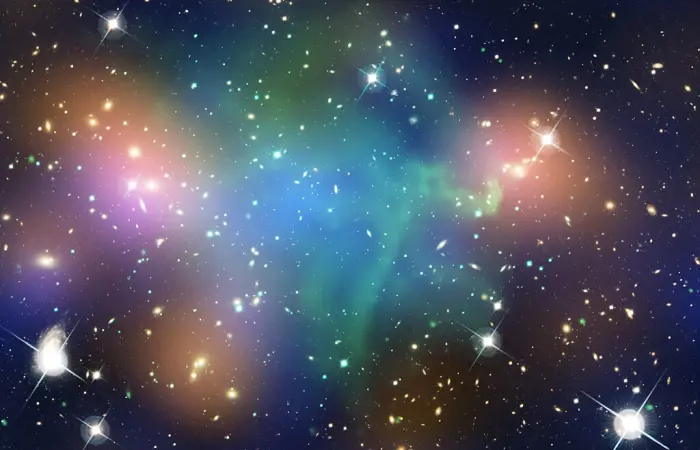
This composite image shows the distribution of dark matter, galaxies, and hot gas in the core of the merging galaxy cluster Abell 520. Data from Chandra (green) show the hot gas in the clusters and provides evidence that a collision took place. Optical data from Hubble and the Canada-France-Hawaii Telescope in Hawaii are shown in red, green, and blue. Starlight from galaxies within the clusters, which has been smoothed to show the location of most of the galaxies, is colored orange. Confirming a previous observation, this result reveals that a clump of dark matter resides near most of the hot gas, where very few galaxies are found. Image credit: Chandra X-ray Observatory Center, Smithsonian Institution (PD)